







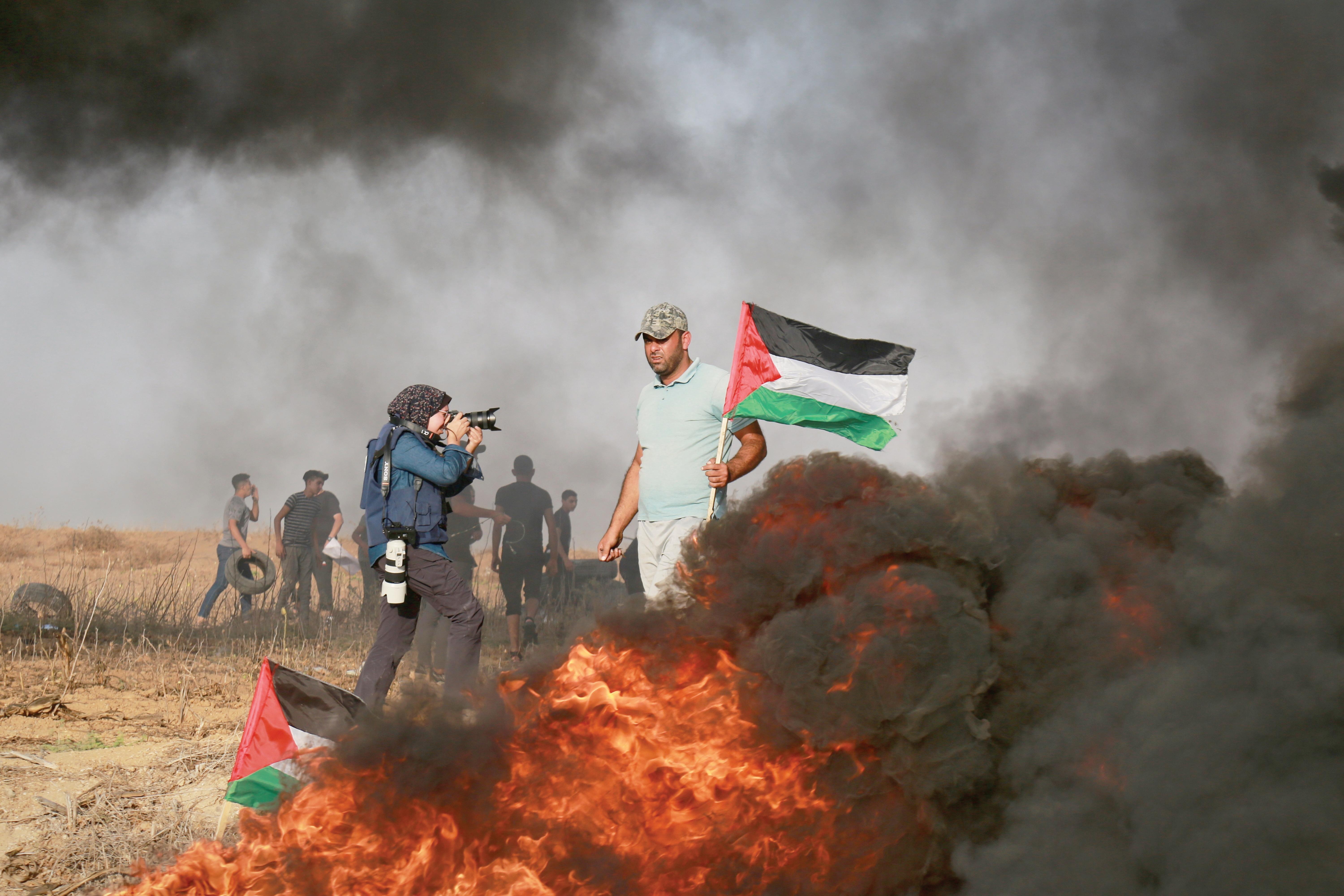
By Fatima Shbair The Associated Press
CAIRO—Two years into the war in Gaza, and as Israel and Hamas reached a deal raising hopes for the end of the conflict, Associated Press photographer Fatima Shbair looked back at some of her most poignant images. Shbair has seen conflict and violence in the territory since she was a young girl, and when Hamas’ October 7, 2023, attack triggered Israel’s campaign of retaliation, she spent several days reporting from her hometown of Gaza City.
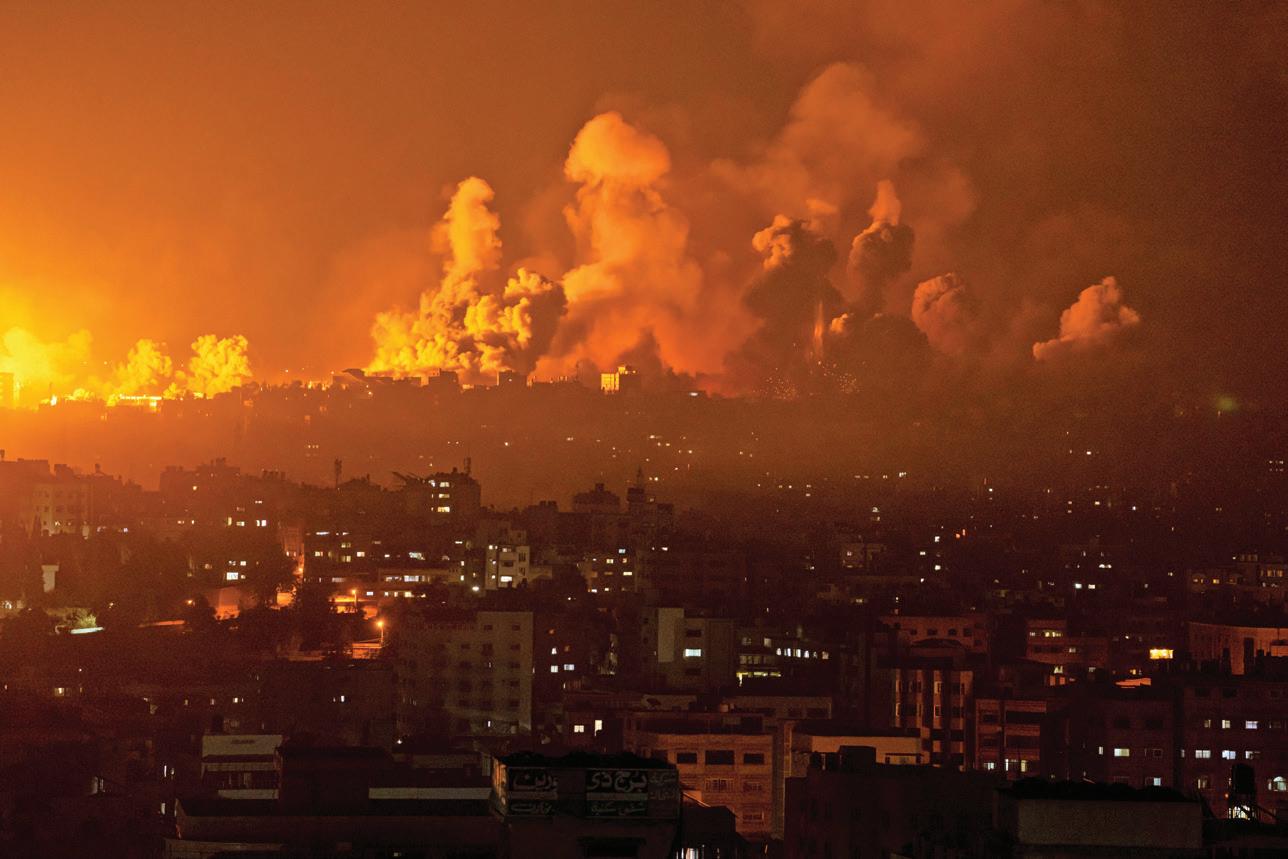
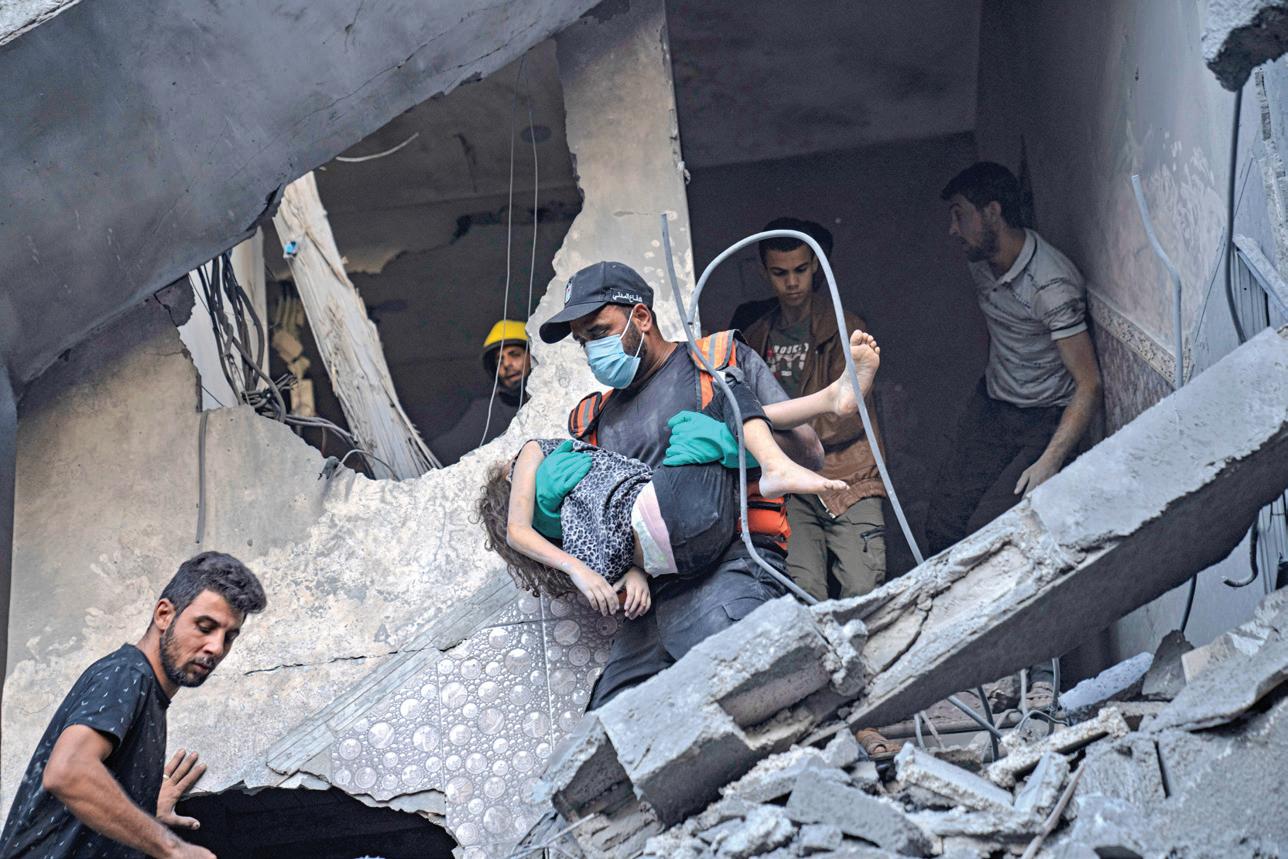
receive the keys for my new home, an apartment I was building on the top floor of my family home. That morning, as I slept, I heard something I thought was rain or voices. It was rockets, launching from every side of Gaza—Hamas had launched its attack on Israel, in which militants killed some 1,200 people and took 251 others hostage.
That night, we waited on the roof of AP’s office building for Israel’s response. It’s a tall building with several news outlets and a view across Gaza City.
Finally, around 3 or 4 a.m., it came. Continuous airstrikes, explosions hitting many places simultaneously. It went all night. We ran to every side of the building, taking pictures. It was the start of Israel’s campaign to recover hostages and eliminate Hamas, whose members and fighters live and operate among Gaza’s population.
Many of my journalist colleagues were on that roof as well. Most have since been killed.
Oct. 19, 2023: Trapped under rubble
This strike happened overnight,
and rescue workers couldn’t go out until morning. People were trapped under rubble for hours. I crawled over wreckage for this shot.
It was less than two weeks into the war, and every day we were running, running, running. Everything happened so fast.
I had moved my parents and siblings to the south. I operated out of the hospital in Khan Younis. From there, we could follow rescue workers rushing to Israeli airstrike scenes.
It became an oppressive, never-pausing routine. Every day, I woke up to blood. I had breakfast in the morgue, next to bodies. We were constantly moving to buildings leveled by airstrikes. At every one, rescue workers carried out bodies and wounded.
After each long day, I slept in my car for a few hours. But it wasn’t really sleep, with all the airstrikes overnight – and the screams of the bereaved. I was parked outside the morgue and could hear the families from inside.
I rarely saw or spoke to my own family. Later, I moved to base myself in the hospital in Ra
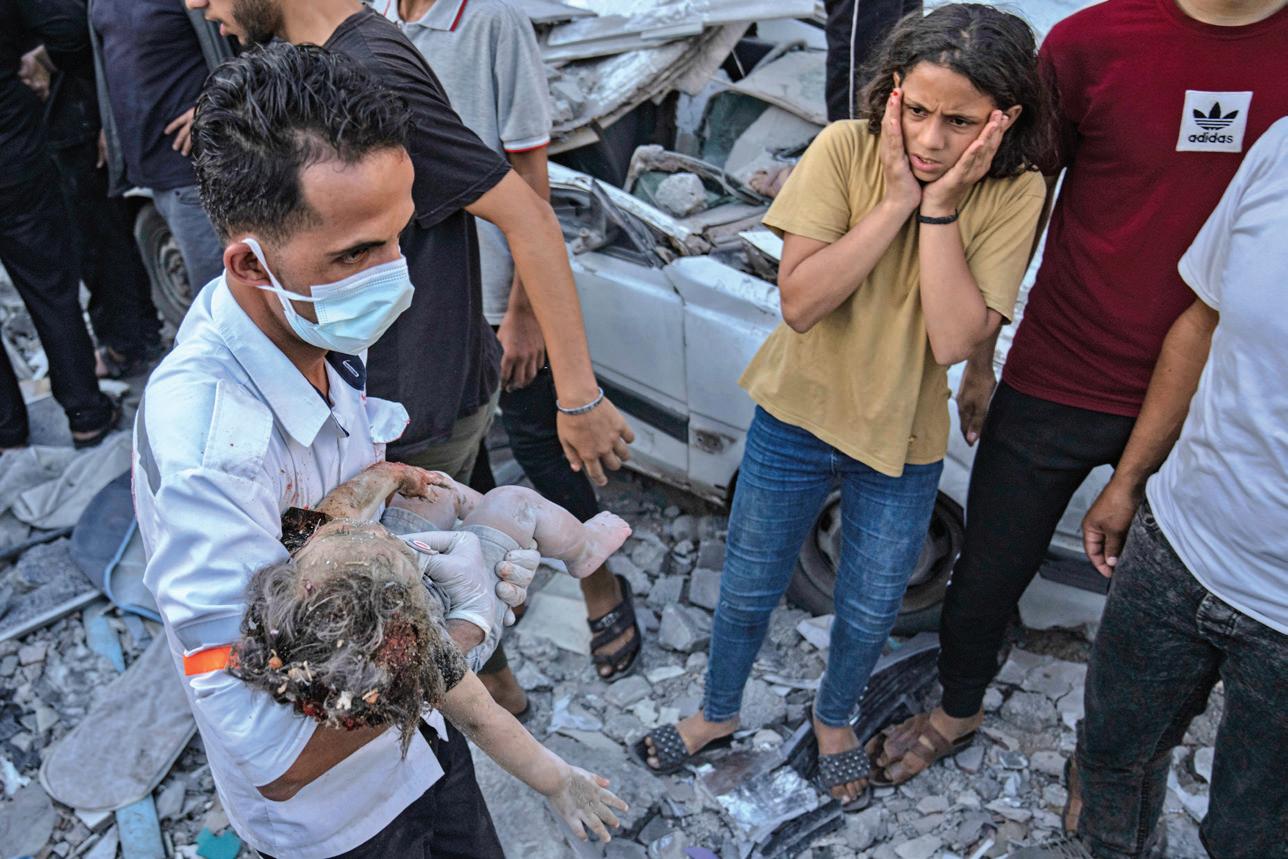
fah, farther south, the city where my family was. I always knew the direction of the house where they were sheltering. When I heard a strike, I looked to see whether the smoke was coming from that direction.
Even if it was, I wouldn’t call my family. If you call, you might hear screaming, you might learn they are injured or buried under rubble.
It was better to wait at the hospital to see if they came in with the casualties. Maybe they would be brought in wounded. Maybe they would be in the morgue. OK, I would face that.
But a call means bad news. I hate calls during war.
Oct. 21, 2023: The toll for the children
An airstrike hit a house in Khan Younis just outside a U.N. school full of people driven from their homes. It wasn’t until I got back to AP’s office tent and looked at this picture that I saw this girl – and the look on her face as emergency workers carried a dead child out of the rubble.
It was early in the war, and the girl still reacted with shock. I thought of myself. As a child, when someone in my family passed away, I was afraid to even be in the same room with them to say goodbye. So what must this girl be thinking? She looked so afraid. But as time went on, it became normal. At the scene of every strike, there were lots of children. They got there before us. They would tell us, “There’s still someone trapped inside. A person is crushed between two floors.” One kid told me he saw a leg sticking out of the rubble. Children, describing things difficult for the brain to even conceive. Later, on one of my last days in Gaza, I was in a hospital morgue. It was a chaotic day, with bodies strewn on the floor, the smell of blood everywhere. A child, maybe 5, collected pieces of one body, putting them in a bag for the family to bury. The adults around him were unfazed, like this was normal. What will a child who picks up body parts off the ground remember?
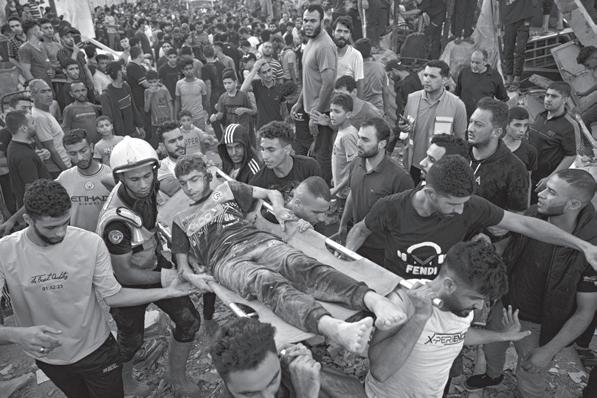
Oct. 21, 2023: Connecting a family AFTER the same strike, I climbed onto a wrecked car and got this shot.
A week later, I got a message on Instagram: “Please reply, it’s urgent.”
It was Dina Ali al-Nazzal, from Denmark, the mother of the boy on the stretcher. More than a decade ago, she said, her husband left her and took the children – Mohammed, then 3, and Layal, 2 – to Gaza. She hadn’t seen them since. She was terrified when she heard their home was struck.
Then she saw my photo of Mohammed, now 14, online.
“Your lens saved a mother’s heart from stopping,” al-Nazzal wrote. She was able to contact the hospital and learn that Layal survived, too.
I became a photographer because of my grandmother. She took pictures when she was young; she
had all these old cameras in our house. I was curious about these machines, like antiques.
After university, I spent a year studying photography. I had so many books and magazines, a million photos on my computer. I started taking pictures of daily life in the streets, on the beach.
I saw a beautiful life in Gaza, something people outside should see. I found I had a story to tell; I could express myself. I did it because I loved photography.
But when this mother contacted me, I realized that our work is important. It can impact the life of someone even far away. We have to be here, on the ground, seeing. You make a difference, even if it’s tiny.
Dec. 14, 2023:
A different kind of death EVERY day we saw bodies – in the morgue. This was different. An airstrike had hit in the market – where doctors do triage, rushing through the flood of wounded to decide who is the priority. You can see this girl is no longer with us. There is nothing in her eyes. But she was breathing. I was frozen, thinking of my younger sister, the same age.
This girl has to live, I thought. I saw the doctors’ hands on her, clearing blood from her mouth. They held her like she was already
a corpse, manipulating her head, touching her eyes. Her name, Maya, was written on her belly with marker. Why don’t you do something, I told them. The doctor looked at me and shook his head.
He came over and told me this was the hardest thing, every day. He urged me to go inside to take more photos. I couldn’t focus. I just wanted to get away.
Finally, Maya stopped breathing. I ran back to our office tent. And I threw up.

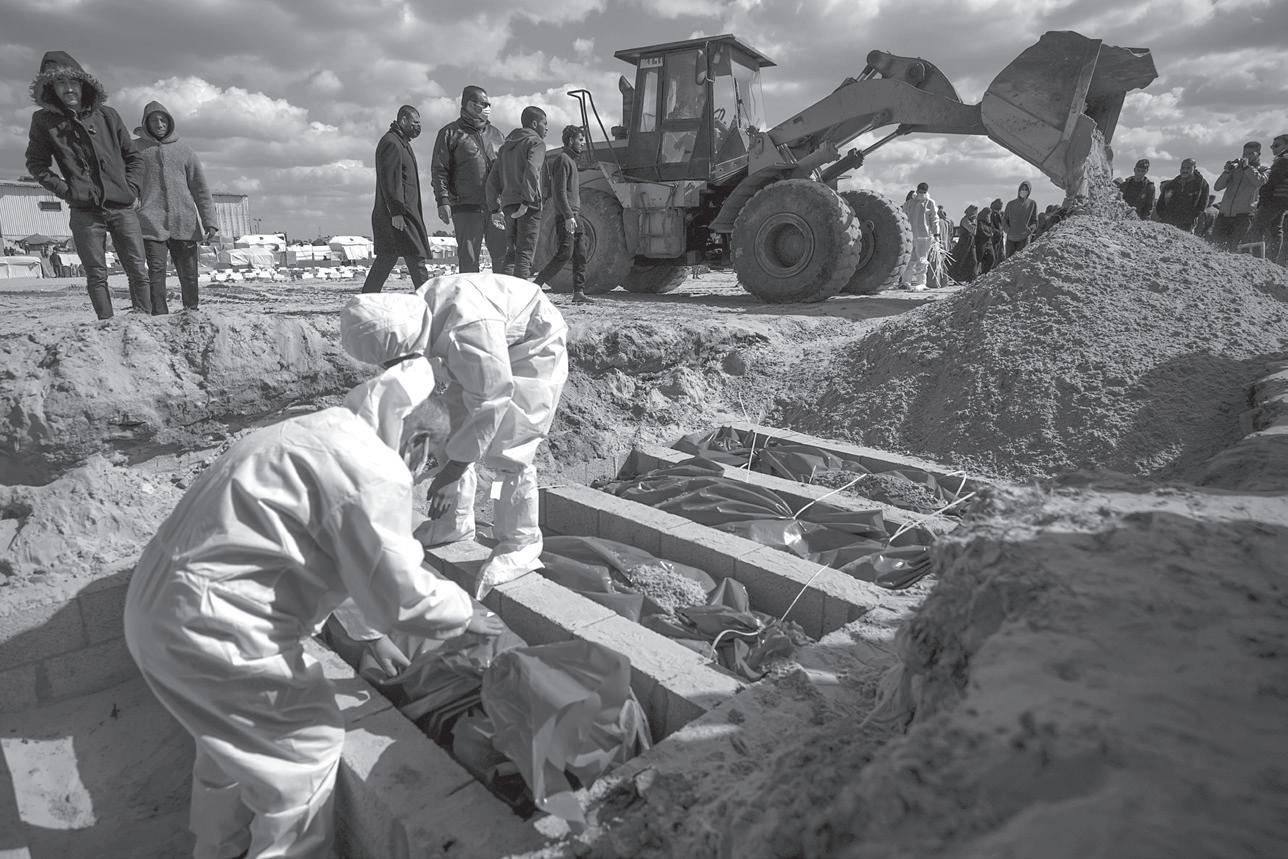


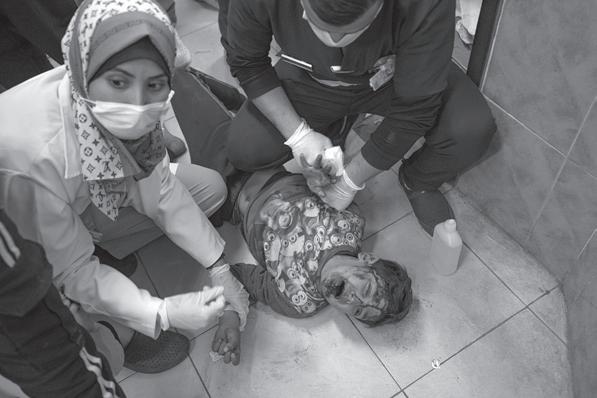
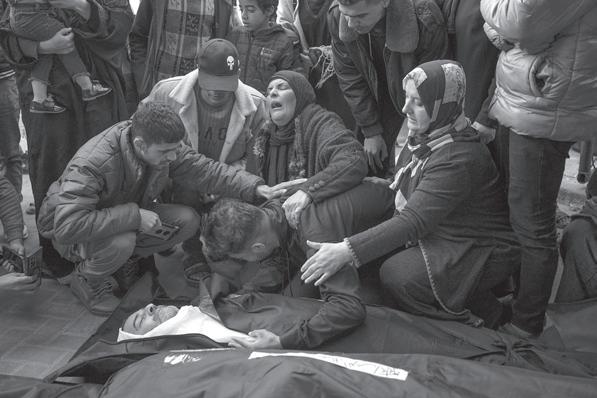
hard. But throughout my career, his words always were in my head: “You are my daughter.”
This girl was supposed to have a future. As I filed this frame, I looked at photos of her on her family’s social media, a little girl laughing, happy. At that moment, I knew she was dead, and they did not. She had been taken by medics from the scene of the strike, and it would take time for her family to find her. I never cry. It’s like my tears are frozen inside my eyes. I always feel I must stay strong—to the point that I lost the ability to cry.
Jan. 30, 2024: The mass grave
IN all Gaza’s past conflicts, we never had mass graves.
These were bodies Israel collected from all over Gaza, particularly the north. They search through them, for bodies of hostages or of Palestinians they identify as militants. Then they send them piled in trucks back to Gaza, dozens or even 100 at a time, with no documents for identification.
You can’t imagine the smell— or so other photographers told me. As a child, I fell and hit my nose. Ever since, I haven’t had a good sense of smell. That helped me. I could get close, nearly into the grave itself.
As I took pictures, I felt like it was for nothing. In the background, you see relatives hoping to find loved ones, maybe see clothes they recognize. But how can they?
Every body was the same, anonymous. But each one had a life. And they never imagined this would be their end—buried nameless, far from home, in a line of strangers.
Feb. 24, 2024:
My father was dying. I was at his bedside in Al-Najjar Hospital in Rafah. He’d been ill for a long time, and the hospitals didn’t have supplies to treat him. Doctors said he didn’t have much time left. He was unconscious, but I wanted to spend every moment with him.
The hospital was quiet. In an instant, it became chaos. The wounded from airstrikes poured in. Doctors, nurses and medics pushed by, jostling my father’s bed. Al-Najjar has a small emergency ward, with few beds, so wounded lay on the floor. A man whose jaw had been blown off – he’d lost half his face – was still walking, trying to survive.
I started taking photos. The whole time, I kept looking back at my dad.
My dad is my hero. He encouraged me in photography. Being a woman journalist in Gaza is
In this moment, I struggled. I wanted to be next to my father. It was painful to see Dad this way, far from our home in Gaza City, chaos all around. But I also felt he’d be proud. He’s with me in his last moments, and I’m doing the thing he loved. I’m his daughter, and I’m strong.
I photographed a wounded child screaming in the hall near Dad’s bed. I was the only photographer there, and I felt a responsibility: If I don’t take this picture, this moment will die with no one knowing.
The boy’s family came. I didn’t know this child, but his family knew him and loved him. They don’t know me, but I have my father whom I love nearby. Each of us is living a nightmare.
The next morning, my brother called from the hospital. My father had died.
March 4, 2024: The mourners
I didn’t cry that day. I had to stay strong for my mother and family. I took some days off.
This was my first day back working. I covered the morgue, showing people coming to say goodbye to loved ones.
I walked slowly. I was afraid to be there, to take just one step inside. But I forced myself.
This man in the photo, he’s lying on the same spot that my dad was. As they wept over him, I felt it all. I saw everything, I saw that day again. My vision was blurring. I was in a different world, spinning, spinning, spinning. I was going to collapse on the bodies.
But Mariam Dagga did not let me collapse. Mariam was there right next to me, taking pictures as well. We often worked together — it’s more comfortable having another woman photographer with you.
She gripped my hand. “Don’t worry. I feel you. I felt it before.”
Her brother had been killed by Israeli fire in 2018. She wanted me to feel my pain so I could be strong again, so I could keep taking photos.
That day, I found the ability to cry. I shed tears for my father. Seventeen months after this photo was made, Mariam, a visual journalist working with the AP, was killed by an Israeli strike on a hospital.
Mariam and I were always by each other’s side. All the work I’ve done since that day she gave me strength is because of Mariam. Maybe the war will last forever, but I will stay strong. Mariam told me to keep doing the job, to keep taking photos.
March 18, 2024: Ramadan Home means everything during Ramadan, Islam’s holy month of fasting.
Nothing in this photo tells you it’s Ramadan. This entire neighborhood in Rafah was destroyed, every house in ruins. All the residents had moved to a U.N. school.
But this family left the shelter to have their Ramadan meal here, in what was their home. Almost nothing is left, just a wall. They made a soup and a salad of tomatoes and cucumbers. They were silent. We were all silent.
I was thinking of my family home, in Gaza City, which has been destroyed.
Now I am outside of Gaza. I wish I were still there. With the new agreement, the war may end. But the faces, the voices, the days we loved are gone, and the struggle with grief and memory has only begun.
What we saw in Gaza made us different from people outside. We may be having a meal, talking, but we are not there. We are in a different world.
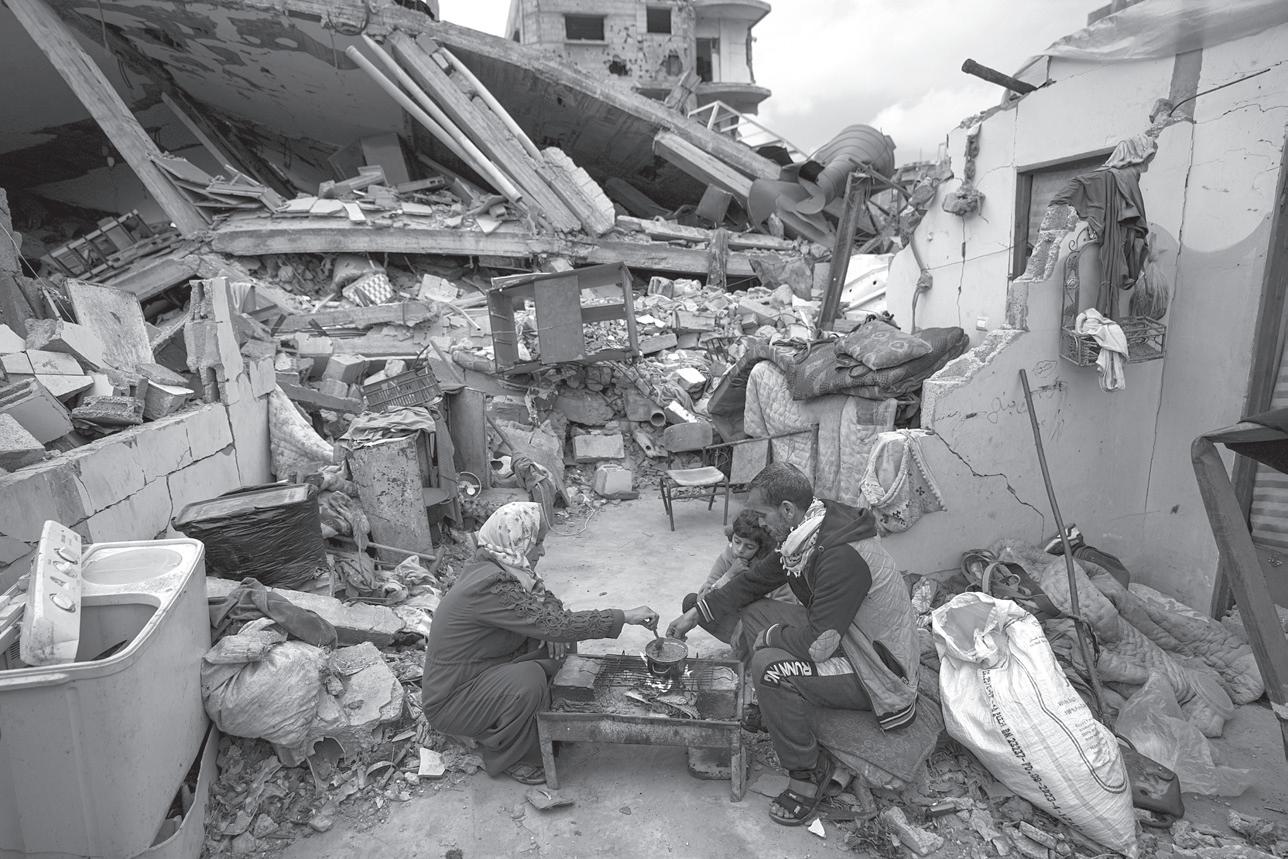
Editor: Angel R. Calso

By Wafaa Shurafa & Sarah El Deeb The Associated Press
Gaza City—
When Israeli bombs began falling, Mohammad al-Najjar, his wife and six children fled their house in southern Gaza in the dead of night, dispersing in terror alongside hundreds of others from their neighborhood.
When the dust settled and alNajjar huddled with his family in a shelter miles away, his son Ahmad, 23, was missing. After daybreak, the family searched in nearby hospitals and asked neighbors if they had seen him. There was no trace. Nearly two years later, they are still looking.
“It is as if the earth has swallowed him,” said Mohammad al-Najjar. He spoke from the family’s tent in
Muwasi, along Gaza’s southern coast, their ninth displacement camp since that fateful night in December 2023. Thousands in Gaza are looking for relatives who have gone missing in one of the most destructive wars of the past decades. Some are buried under destroyed buildings. Others, like al-Najjar’s son, simply disappeared during Israeli military operations. In a war where the true
number of the dead is unknown, “what the accurate number (of missing persons) is, nobody knows,” said Kathryne Bomberger, director general of the International Commission on Missing Persons.
The al-Najjar family has searched through the rubble of their bombed-out home. They went to morgues and checked with the International Committee for the Red Cross.
“Is he a prisoner (in Israel), is he dead?” the 46-year-old father said. “We are lost. We are tormented by everything.”
The Israeli Prison Services and the military said they could not release identifying details about specific prisoners and refused to comment on alNajjar’s status.
An enormous task
SOME 6,000 people have been reported by relatives to still be buried under rubble, according to the Health Ministry. The true number is likely thousands higher because in some cases entire families were killed in a single bombing, leaving no one
to report the missing, said Zaher al-Wahidi, the ministry official in charge of data.
Separately, the ministry received reports from families of some 3,600 others missing, alWahidi said, their fate unknown. So far, it has only investigated over 200 cases. Of them, seven were found detained by Israel. The others were not among those known to be dead or buried under rubble.
The ministry is part of the Hamas-run government. The UN and many independent experts consider its figures to be reliable.
The ICRC has its own separate list of missing—at least 7,000 cases still unresolved, not including those believed to be under rubble, said chief spokesman Christian Cardon.
There have been many ways to disappear during the chaos of offensives, strikes on buildings and mass displacements of almost all of Gaza’s 2.3 million people. Hundreds have been detained at Israeli checkpoints or were rounded up in raids with no notification to their families.
During Israeli ground assaults, bodies have been left in the streets. Palestinians have been shot when they came too close to Israeli military zones and their bodies are found weeks or months later, decomposed.
The Israeli military has taken an unknown number of bodies, saying it is searching for Israeli hostages or Palestinians it identifies as militants. It has returned several hundred corpses with no identification to Gaza, where they were buried in anonymous mass graves.
Investigating the missing requires advanced DNA technology, samples from families and unidentified bodies, and aerial imagery to locate burial sites and mass graves, said Bomberger. “It is such an enormous undertaking,” she said.
But Israel has restricted DNAtesting supplies from entering Gaza, according to Bomberger and the Gaza Health Ministry.
Israeli military authorities would not immediately comment when asked if they were banned.
Bomberger said it is the
state’s responsibility to find missing persons—in this case, Israel, as the occupying power. “So, it would depend on the political will of the Israeli authorities to want to do something about it.”
Scent of her son FADWA AL-GHALBAN has had no word about her 27-year-old son Mosaab since July, when he went to get food from their family house, believing Israeli troops had already left the area near the southern town of Maan. His cousins nearby saw Mosaab lying on the ground. They shouted his name, but he didn’t answer, and with Israeli troops nearby it was too unsafe to approach him and they left. They presumed he was dead. Returning later, family members found no body, only his slippers.
Her family has put up notices on social media, hoping someone saw Mosaab in Israeli detention or buried him after finding his body.
See “Gaza,” A4

By Giovanna Dell’orto The Associated Press
TAYBEH, West Bank—Early on Sundays, bells call the faithful to worship at the three churches in this hilltop village that the Gospel narrates Jesus visited. It is now the last entirely Christian one in the occupied West Bank.
Proudly Palestinian, Taybeh’s Christians— Catholics of the Roman and Greek Melkite rites, and Greek Orthodox—long most for independence and peace for this part of the Holy Land.
But that hope feels increasingly remote as they struggle with the threats of violence from Jewish settlers and the intensifying restrictions on movement imposed by Israel. Many also say they fear Islamist radicalization will grow in the area as conflicts escalate across the region.



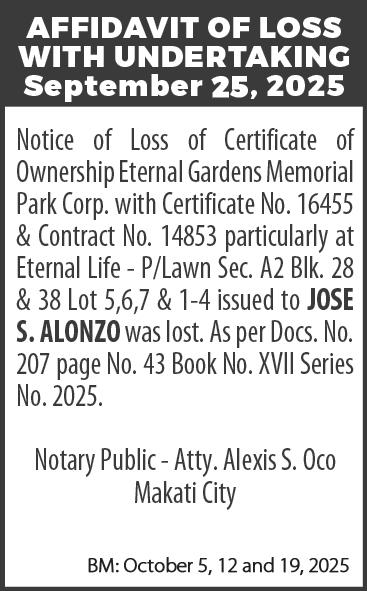

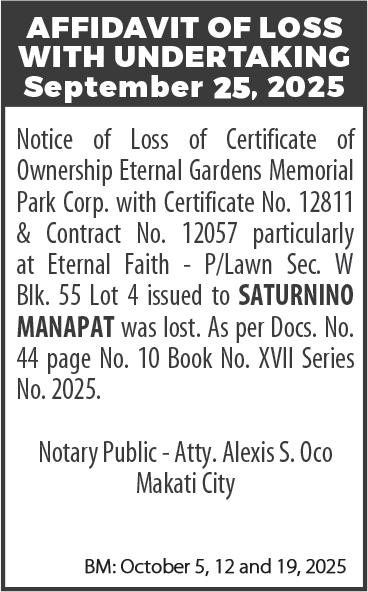



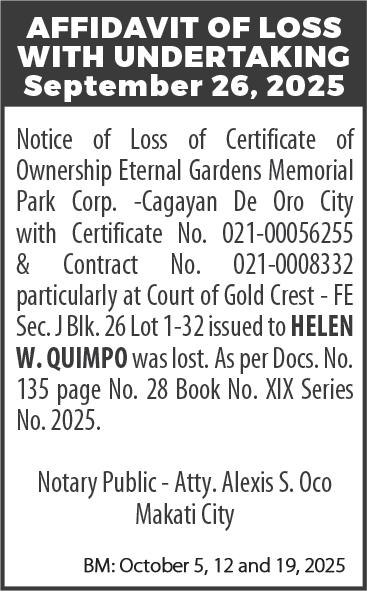
And even Thursday’s announcement of an agreement to pause fighting in Gaza didn’t assuage those urgent concerns.
“The situation in the West Bank, in my opinion, needs another agreement—to move away and expel the settlers from our lands,” the Rev. Bashar Fawadleh, parish priest of Christ the Redeemer Catholic Church, told The Associated Press. “We are so tired of this life.”
On a recent Sunday, families flocked to Mass at the church, where a Vatican and a Palestinian flag flank the altar, and a tall mosaic illustrates Jesus’ arrival in the village, then called Ephraim.
More families gathered at St. George Greek Orthodox Church. Filled with icons written in Arabic and Greek, it’s just down the street, overlooking hillside villas among olive trees.
“We’re struggling too much. We don’t see the light,” said its priest, the Rev. David Khoury. “We feel like we are in a big prison.”
A decades-old conflict spirals THE West Bank is the area between Israel and Jordan that Israel occupied in the 1967 war and that Palestinians want for a future state, together with east Jerusalem and the Gaza Strip. Israel seized them from Jordan and Egypt in that war.
The Israel-Hamas war that has devastated Gaza since Hamas-led militants attacked Israel on Oct. 7, 2023, has affected the strip’s tiny Christian community. The Catholic church was hit by an Israeli shell in July, though it’s functioning again.
Violence has also surged in the West Bank. Israeli military operations have grown to respond to what the army calls an increasing militant threat, most visible in frequent attacks at checkpoints.
Palestinians say uninvolved civilians have been caught up in the raids and blame the army for not defending them from near-daily violence by settlers.
After leading the music ministry at a recent Sunday’s Catholic Mass, as he’s done for six decades, Suheil Nazzal walked to the village’s edge to survey his terraces of olive trees.
Settlers no longer allow him and other villagers to harvest them, he said. He also blames the settlers on an opposite hilltop for setting a fire this summer that burned dangerously close to the cemetery where his parents are buried and to
Al-Ghalban lives off hope. Another relative had been presumed dead, then four days after the family formally received those giving condolences, they learned he was in an Israeli prison.
Whatever her son’s fate, “there is a fire in my heart,” al-Ghalban said. “Even if someone buried him, it is much easier than this fire.” Rights groups say Israel is “disappearing” hundreds of Palestinians from Gaza, detaining them without charges or trial, often incommunicado. Israel does not make public the number being held, except through Freedom of Information Act requests.
Under a wartime revision to Israeli law, detainees from Gaza can be held without any judicial review for 75 days and denied lawyers for even longer. Appearances before a judge usually take place in secret via video.
The Israeli human rights group Hamoked obtained records showing that, as of September, 2,662 Palestinians from Gaza were held in Israeli prisons, in addition to a few hundred others detained in army facilities where rights groups, the UN and detainees have reported routine abuse and torture.

the ruins of Taybeh’s oldest church, the 5th-century St. George.
Christian families leaving the Holy Land NAZZAL plans to stay in Taybeh, but his family lives in the US. Clergy said at least a dozen families have left Taybeh, population 1,200, and more are considering leaving because of the violence, dwindling economy opportunities, and the way checkpoints restrict daily life.
Victor Barakat, a Catholic, and his wife Nadeen Khoury, who is Greek Orthodox, moved with their three children from Massachusetts to Taybeh, where Khoury grew up.
“We love Palestine,” she said after attending a service at St. George. “We wanted to raise the children here, to learn the culture, the language, family traditions.”
Yet while hoping they can stay in Taybeh, they say the security situation feels even more precarious than during the intifada, or Palestinian uprising, of the early 2000s, when hundreds of Israelis were killed, including in suicide bombings, and thousands of Palestinians were killed in Israeli military operations.
“Everyone is unsafe. You never know who’s going to stop you,” Barakat said, adding they no longer take the children to after-school activities because of the lack of protections on the roads.
And while he rejoiced for the agreement to pause fighting in Gaza, he doubted it would have an impact on settler attacks nearer home.
“The agenda for the West Bank is still more complicated,” Barakat said.
Taybeh’s Christian churches run schools, ranging from kindergarten
to high school, as well as sports and music programs. The impact on young people of the current spiral of mistrust and violence is worrisome for educators.
“We don’t feel safe when we go from here to Ramallah or to any (village) in Palestine. Always there is a fear for us to be killed, to be … something terrible,” said Marina Marouf, vice principal at the Catholic school.
She said students have had to shelter at the school for hours waiting for the opening of “flying checkpoints”—road gates that Israeli authorities close, usually in response to attacks in the area.
Trying to keep the presence—and the faith FROM villages like Taybeh to once popular, now struggling tourist destinations like Bethlehem, Christians account for between 1%-2% of the West Bank’s roughly 3 million residents, the vast majority Muslim. Across the wider Middle East, the Christian population has steadily declined as people have fled conflict and attacks.
But for many, maintaining a presence in the birthplace of Christianity is essential to identity and faith.
“I love my country because I love my Christ,” Fawadleh said. “My Christ is Ibn Al-Balad,” he added, using an Arabic term meaning “son of the land.” Israel, whose founding declaration includes safeguarding freedom of religion and all holy places, sees itself as an island of religious tolerance in a volatile region. But some church authorities and monitoring groups have lamented a recent
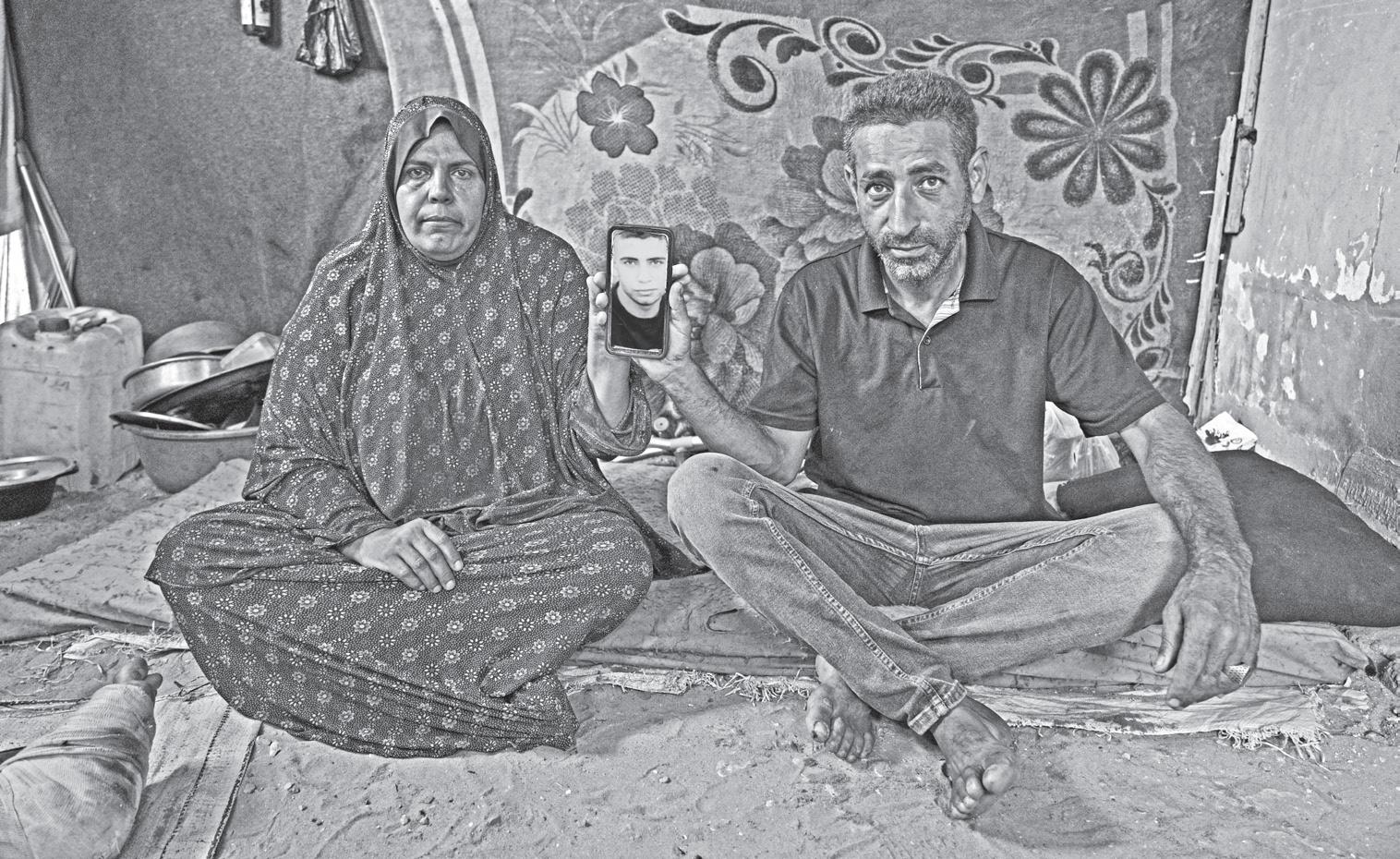
All al-Ghalban has left of her son is his last change of clothes. She refuses to wash them.
“I keep smelling them. I want a scent of him,” she said, her voice cracking into tears. “I keep imagining him coming, walking toward me in the tent. I say he is not dead.”
Even a ring WITH most of Gaza’s bulldozers destroyed, families must search on
increase in anti-Christian sentiment and harassment, particularly in Jerusalem’s old city.
While those targeting Christians are a tiny minority of Jewish extremists, attacks such as spitting toward clergy are enough to create a sense of impunity and thus overall fear, said Hana Bendcowsky. She leads the Jerusalem Center for Jewish-Christian Relations of the Rossing Center for Education and Dialogue.
The Catholic Church’s Latin Patriarch of Jerusalem, Cardinal Pierbattista Pizzaballa, has also highlighted growing problems in the West Bank, from settlers’ attacks to lack of jobs and of permits to move freely, adding that more Christians might decide to leave.
For the Franciscan priest who’s the new custodian of the Holy Land and oversees more than 300 friars in the region ministering to various holy sites, “the first big duty we have here is to stay.”
“We can’t stop the hemorrhage, but we will continue to be here and be alongside everyone,” said the Rev. Francesco Ielpo, whom Pope Leo XIV confirmed three months ago to the Holy Land mission established by St. Francis more than 800 years ago.
Struggling to provide hope amid despair
IELPO said the biggest challenge for Christians is to offer a different approach to social fractures deepened by the war in Gaza.
“Even where before there were relationships, opportunities for an encounter or even just for coexistence, now suspicions arise. ‘Can I trust the other? Am I really safe?’” he said.
Michael Hajjal worships at Taybeh’s Greek Orthodox church, and is torn between his love for the village, the constant fear he feels, and the concern for his son’s future.
“What kind of future can I create for my son while we’re under occupation and in this economic situation?” he said. “Even young people of 16 or 17 years old are saying, ‘I wish I were dead.’”
Hope—in addition to practical help ranging from youth programs to employment workshops—is what the clergy of Taybeh’s churches are working together to provide in the face of such despair.
“Still we are awaiting the third day as a Palestinian,” Fawadleh said. “The third day that means the new life, the freedom, the independence and the new salvation for our people.”
Dalia and her husband were killed in their home on Oct. 9, 2023, the third day of the war. Her children survived. They now live with their grandfather. “We searched and we could not find her,” Nassar said. “She seemed to have evaporated with the rocket.”
A year later, Israel struck the family’s home, burying Mahmoud, who had returned to shower in the house after the family had evacuated.
When the ceasefire began in January, Nassar and his wife Khadra went to search for him. Every day, the 60-yearold father of 10, a former construction worker, used a hammer, shovel and small tools to chip away at the rubble. His wife carried away buckets of sand and debris. They dug through half the house and found nothing. Then Israel broke the ceasefire in March and they had to flee.
their own through wreckage, hoping to find even the bones of lost loved ones.
Khaled Nassar’s daughter, Dalia, 28, and his son, Mahmoud, 24, were killed in separate airstrikes, leaving both buried under their homes in the Jabaliya refugee camp.
Rescue workers have largely been unable to access Jabaliya, which was hit by repeated strikes, raids and ground offensives and is now under Israeli military control and off-limits.
Khadra refuses to despair. If there is a new ceasefire, she will resume digging, she said, “even if I only find (Mahmoud’s) ring on his finger or some bones to put in a grave to call it my son’s.”
Sunday, October 12, 2025
By Kostya Manenkov & Geir Moulson
OThe Associated Press
SLO, Norway—Opposition
activist María Corina Machado of Venezuela won the Nobel Peace Prize on Friday.
The former opposition presidential candidate in Venezuela was lauded for being a “key, unifying figure in a political opposition that was once deeply divided—an opposition that found common ground in the demand for free elections and representative government,” said Jørgen Watne Frydnes, chair of the Norwegian Nobel committee.
“In the past year, Miss Machado has been forced to live in hiding. Despite serious threats against her life, she has remained in the country, a choice that has inspired millions. When authoritarians seize power, it is crucial to recognize courageous defenders of freedom who rise and resist.”
President Nicolás Maduro’s government routinely targeted its real or perceived opponents ahead of last year’s presidential election.
Machado was set to run against Maduro, but the government disqualified her. Edmundo González took her place. He had never run for office before. The lead-up to the election saw widespread repression including disqualifications, arrests and human rights violations.
The crackdown on dissent only increased after the country’s National Electoral Council, which is stacked with Maduro loyalists, declared him the winner despite credible evidence to the contrary.
The election results announced by the Electoral Council sparked protests across the country to which the government responded with force and ended with more than 20 people dead. They also prompted an end to diplomatic relations between Venezuela and various foreign countries, including Argentina.
Machado went into hiding and has not been seen in public since January. A Venezuelan court issued an arrest warrant for González, who moved to Spain and was granted asylum.
Last year, Machado and González were awarded the European Union’s top human rights honor, The Sakharov Prize.
There had been persistent speculation ahead of the announcement about the possibility of the prize going to US President Donald Trump, fueled in part by the president himself, amplified by this week’s approval of his plan for a ceasefire in the Gaza Strip.
Asked about lobbying for and by Trump, Frydnes said: “I think this committee has seen any type of campaign, media attention. We receive thousands and thousands of letters every year of people wanting to say what for them leads to peace.
“This committee sits in a room filled with the portraits of all laureates, and that room is filled with both courage and integrity. So, we base only our decision on the work and the will of Alfred Nobel.”
Last year’s award went to Nihon Hidankyo, a grassroots movement of Japanese atomic bombing survivors who have worked for decades to maintain a taboo around the use of nuclear weapons.
The peace prize is the only one of the annual Nobel prizes to be awarded in Oslo, Norway.
Four of the other prizes have already been awarded in the Swedish capital, Stockholm this week—in medicine on Monday, physics on Tuesday, chemistry on Wednesday and literature on Thursday. The winner of the prize in economics will be announced on Monday.

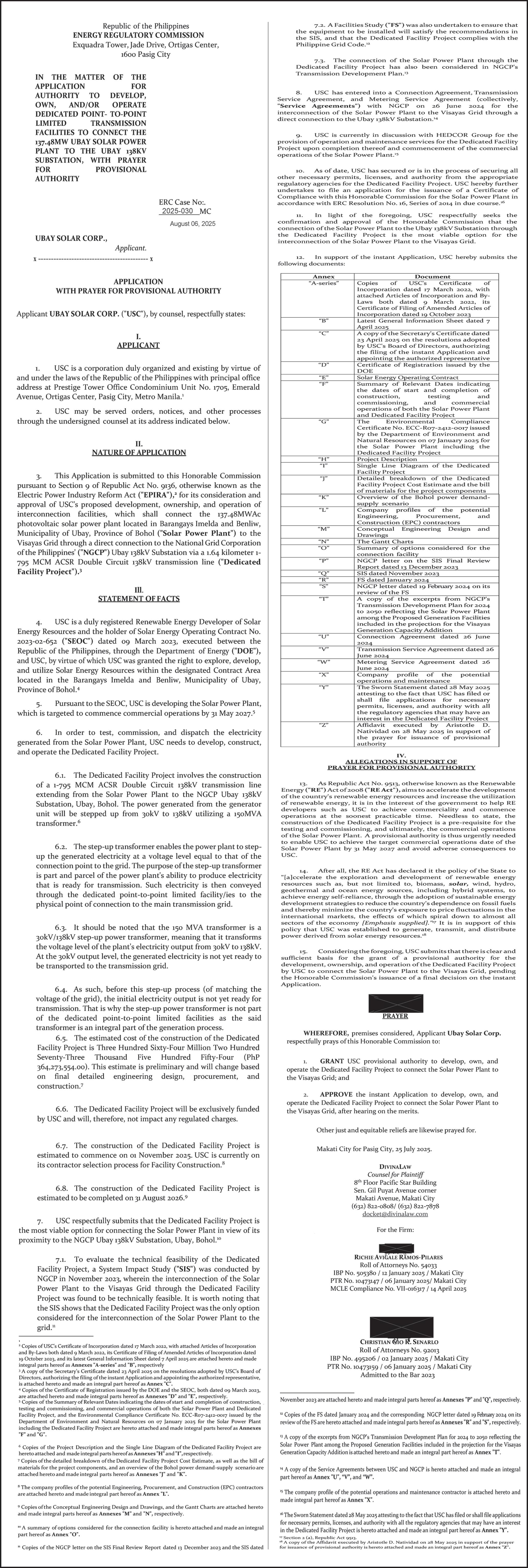
By Lucy White & Sudhi Ranjan Sen
INDIA’S Narendra Modi and the UK’s Keir Starmer—two prime ministers on the receiving end of recent waves of US tariffs—made their case this week for preserving the old free trade orthodoxy being challenged by President Donald Trump.
Modi rolled out a lavish welcome for Starmer in Mumbai, raising 5,700 billboards and posters around the Indian financial hub celebrating the trade deal the two men signed in July. The British prime minister, in turn, brought some 126 executives, business representatives and university chiefs, joking that he needed a bigger plane to fit them and urging them to come home with deals.
While neither leader mentioned Trump’s tariffs, both pushed back on the sort of zero-sum approach to trade that has defined the US president’s negotiations with allies and rivals alike. “India and UK have shown the world the way on global trade and using that trade as a win-win partnership,” Modi told a global fintech conference on Thursday.
Starmer similarly called the UK’s expanded relationship with its fast-growing former colony “a huge win” for both nations.
“Both Prime Minister Modi and I recognize that in a world which
is more uncertain now in trade and the economy, it is significant that two important and great democracies, the UK and India, have signed this agreement provided that stability and that certainty, because that’s what provides the opportunities,” he told reporters before leaving Mumbai.
Modi and Starmer are looking for all the stability they can find in a fracturing world order, with Trump slapping levies on their exports and upending the security landscapes in their respective backyards. Modi has in recent weeks burnished his ties with Russia and China amid a trade standoff with Trump, who imposed 50% tariffs on Indian goods and cracked down on skilled worker visas in a blow to the Indian service sector.
While Starmer’s courtship of Trump—the UK hosted the billionaire Republican for a rare second state visit last month— has helped spare Britain the worst of the tariffs, its relatively small, open economy
faces increasing threats from protectionist responses to the US. Earlier this week, Britain was swept up in European Union plans to levy tariffs of 50% on foreign steel, despite Starmer’s reset efforts with Brussels in the wake of Brexit.
The India deal is the biggest signed by Britain since leaving the European Union in 2020 and could provide New Delhi with a model for a subsequent pact with Brussels. The agreement is expected to increase two-way trade between the countries by 39% over the next 15 years, adding 0.2% to British economic output, according to a UK analysis.
Modi called India and the UK “natural partners” while hosting Starmer at Mumbai’s Raj Bhavan, the official residence of the governor of Maharashtra. Their mutual embrace of lower trade barriers runs counter to Trump’s pursuit of deals aimed at re-balancing bilateral commerce in the US’s favor and underscores how some major economies are resisting his protectionist vision.
“There is a core in the multilateral trading system that continues to work well,” Ngozi Okonjo-Iweala, the director-general of the World Trade Organization, told reporters this week.
Starmer touted £1.3 billion ($1.7 billion) of investments by Indian companies during the trip, which the UK said would create 6,900 jobs. Graphcore, the British chip designer owned by SoftBank Group Corp., announced plans to spend £1 billion on infrastructure in India
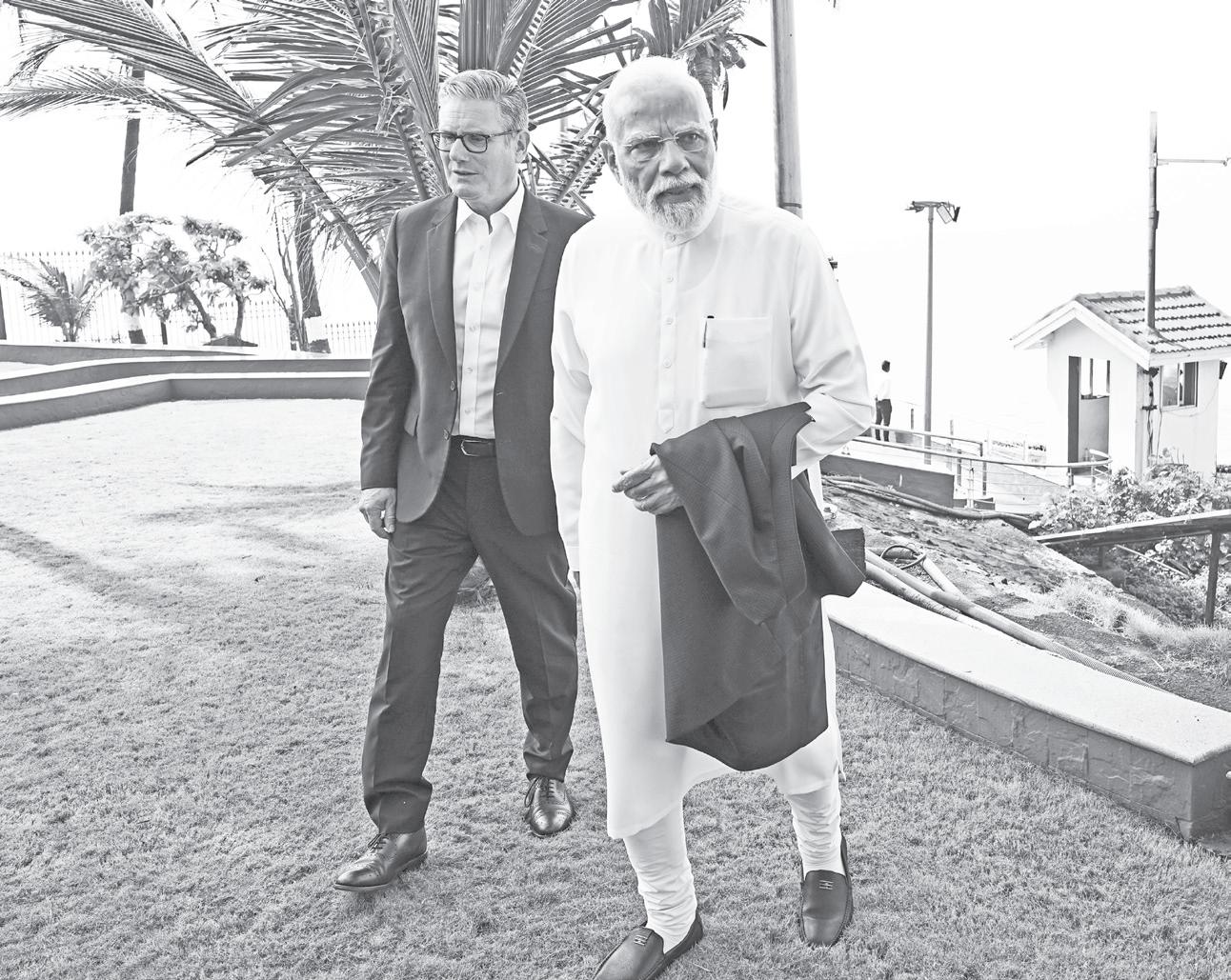
over the next decade, confirming an earlier report by Bloomberg.
During their meeting, Starmer and Modi pledged to deepen cooperation across sectors including education, technology, critical minerals, and defense. Major UK universities also laid out plans to expand their campuses in the South Asian nation.
On Wednesday, Starmer also met with Infosys Ltd. co-founder Nandan Nilekani—widely credited with implementing India’s Unique ID system in 2009—to seek advice on introducing a similar program in the UK.
Starmer needs to correct the narrative at home amid slow growth and stubbornly low approval ratings that have led members of his own Labour Party to question his leadership.
At the fintech conference, Starmer was introduced as a “visionary.”
Thus, the British prime minister was willing to overlook awkward points of disagreement with Modi, such as the Indian leader’s warm birthday phone call to Russian President Vladimir Putin just before the start of the trip to Mumbai. While Starmer said he and Modi discussed India’s purchases of Russian oil, he highlighted Britain’s push to stop the “shadow fleet” of tankers helping to fund Moscow’s war effort.
The Indian prime minister said that he and Starmer also discussed the “ongoing conflict in Ukraine” during their talks, without mentioning oil.
Secretary of State for Scotland Douglas Alexander, who accompanied Starmer on
the trip, hinted ahead of the Modi meeting that the UK wouldn’t push too hard on the issue. The two countries had “different approach towards Russia,” Alexander told reporters on Wednesday, arguing that one of Starmer’s strengths was his “ability to build strong personal relationships preceding policy success.”
While Starmer also said he had broached with Modi the case of Jagtar Singh Johal, a Sikh activist from Scotland who’s been detained in India for eight years, he gave no update on whether Johal would be released.
Indeed, Modi and Starmer pledged to deepen security ties, including expanded coproduction of weapons and equipment. Starmer reaffirmed Britain’s support for India to join it with a permanent seat on the UN Security Council. Still, there were limits to the amount of globalism Starmer, who has come under intense pressure back home to bring down immigration, was willing to embrace. The British prime minister vowed to resist demands from businesses to allow more highly skilled workers from India to come to the UK.
Speaking at a football pitch near Mumbai’s Oval Maidan cricket ground on Wednesday, he said none of the business leaders on the trip had brought up the visa issue. “That wasn’t part of the FTA,” he said. With assistance from Saket Sundria, Swati Gupta, Brendan Murray, Alex Morales and Anup Roy/Bloomberg
By Mari Yamaguchi
TThe Associated Press
OKYO—The head of Japan’s Komeito says it is leaving the ruling coalition headed by the Liberal Democratic Party due to concerns over corruption, in a major setback for the woman who hopes to become the country’s next prime minister. The decision announced Friday by Komeito leader Tetsuo Saito deals a serious blow to the Liberal Democrats, who last weekend chose Sanae Takaichi, an ultra-conservative lawmaker, as its leader.


Takaichi could still become Japan’s first female prime minister, but the departure of the Buddhist-backed Komeito will compel the Liberal Democrats to find at least one other coalition partner in order to stay in power.
Speaking to reporters, she said Saito had “one-sidedly announced the decision to leave the coalition” even though she and her deputy, LDP Secretary General Shunichi Suzuki, had said the Liberal Democrats would discuss the issues he raised and respond promptly.



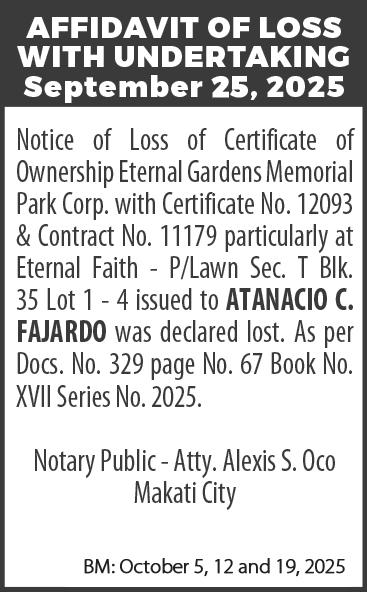
“We’ve been together for 26 years and it was extremely disappointing, but this is how we ended up,” Takaichi said.
The ruling coalition had already lost its majorities in both houses of parliament. The lower house is due to vote on a new prime minister later this month.
Saito said his party, which has been a coalition partner with the Liberal Democrats for 26 years, had raised several concerns in a meeting with its leaders.
They include objections to Takaichi’s stance about Japan’s wartime history and her visits to Yasukuni Shrine, seen as a symbol of its past militarism. Another was Takaichi’s hardline
position toward foreigners, part of a backlash against growing numbers of foreign workers and tourists.
But the deciding factor, he said, was the Liberal Democrats’ response to scandals over the use of political slush funds.
Saito said he found Takaichi’s response to his concerns over history, the Yasukuni visits and foreigners to be acceptable. But he said she showed a lack of “sincerity” about doing more to clean up corruption.
“The LDP’s response was that it will think about it, which was highly insufficient and extremely disappointing,” Saito said.

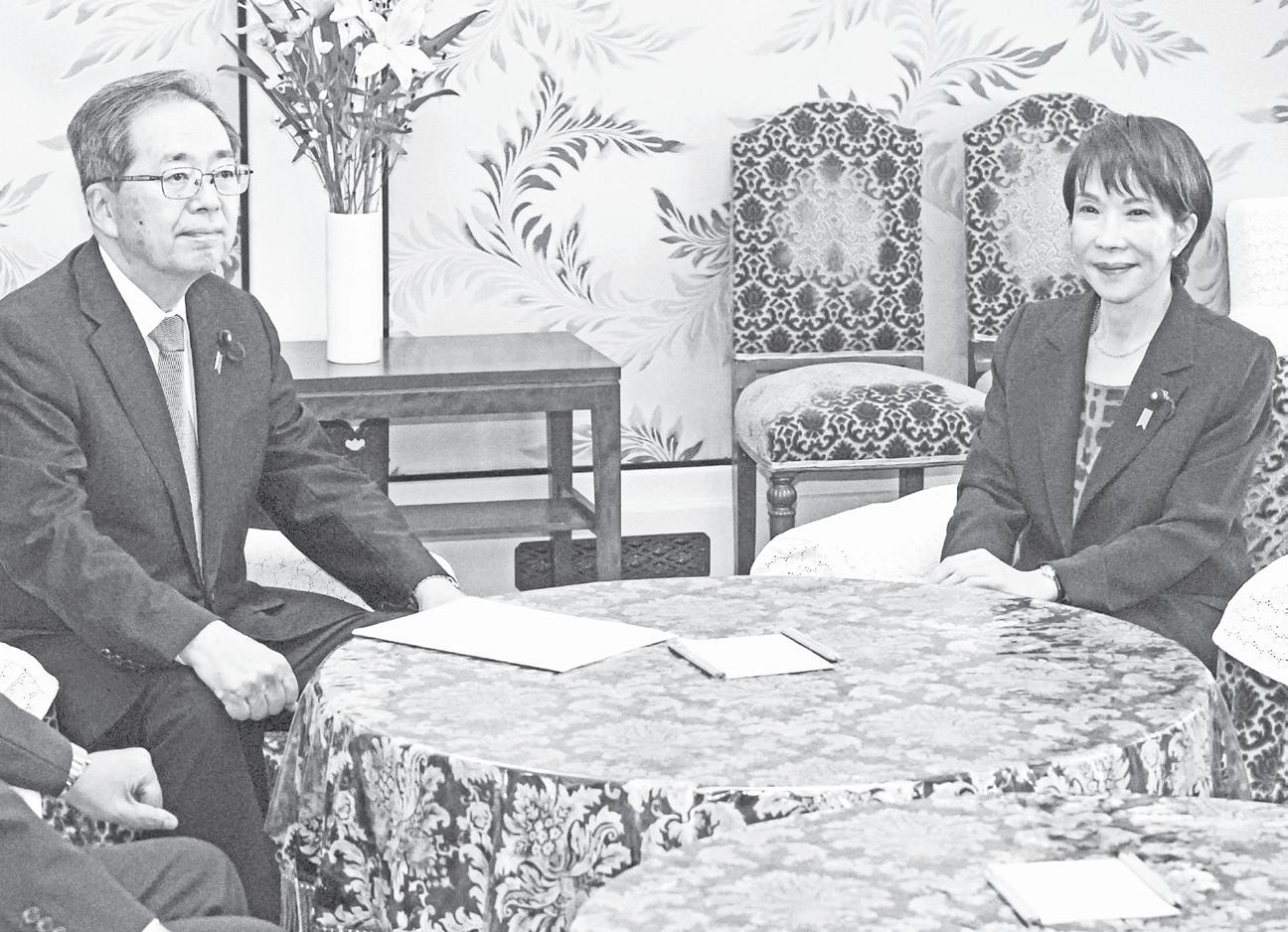
“We have decided to return to the drawing board and stop here,” Saito said. “Our endeavor against money politics is the highest priority for the Komeito.”
Komeito was founded in 1964 by the leader of the Buddhist sect Soka Gakkai, Daisaku Ikeda, to represent diverse public interests and fight corruption, as an alternative to political parties backed by labor unions and big corporations.
The LDP has been beset by scandals involving dozens of lawmakers, many of them belonging to a party faction previously led by the late Prime Minister Shinzo Abe. Abe’s vision for Japan is one that Takaichi has emulated. The Liberal Democrats have
removed some senior lawmakers from top party and Cabinet posts. Takaichi has said that if she is chosen to be prime minister, she plans to put them back into key positions after they were re-elected twice more after their ousters.
Saito told reporters Komeito lawmakers would not vote for Takaichi to become prime minister and the party won’t perform its usual role of trying to drum up support for LDP politicians, who have long relied on votes from Soka Gakkai members, the Komeito’s main source of support. In the vote to replace departing Prime Minister Shigeru Ishiba, expected around Oct. 20, he said, “I will vote for Tetsuo Saito.”


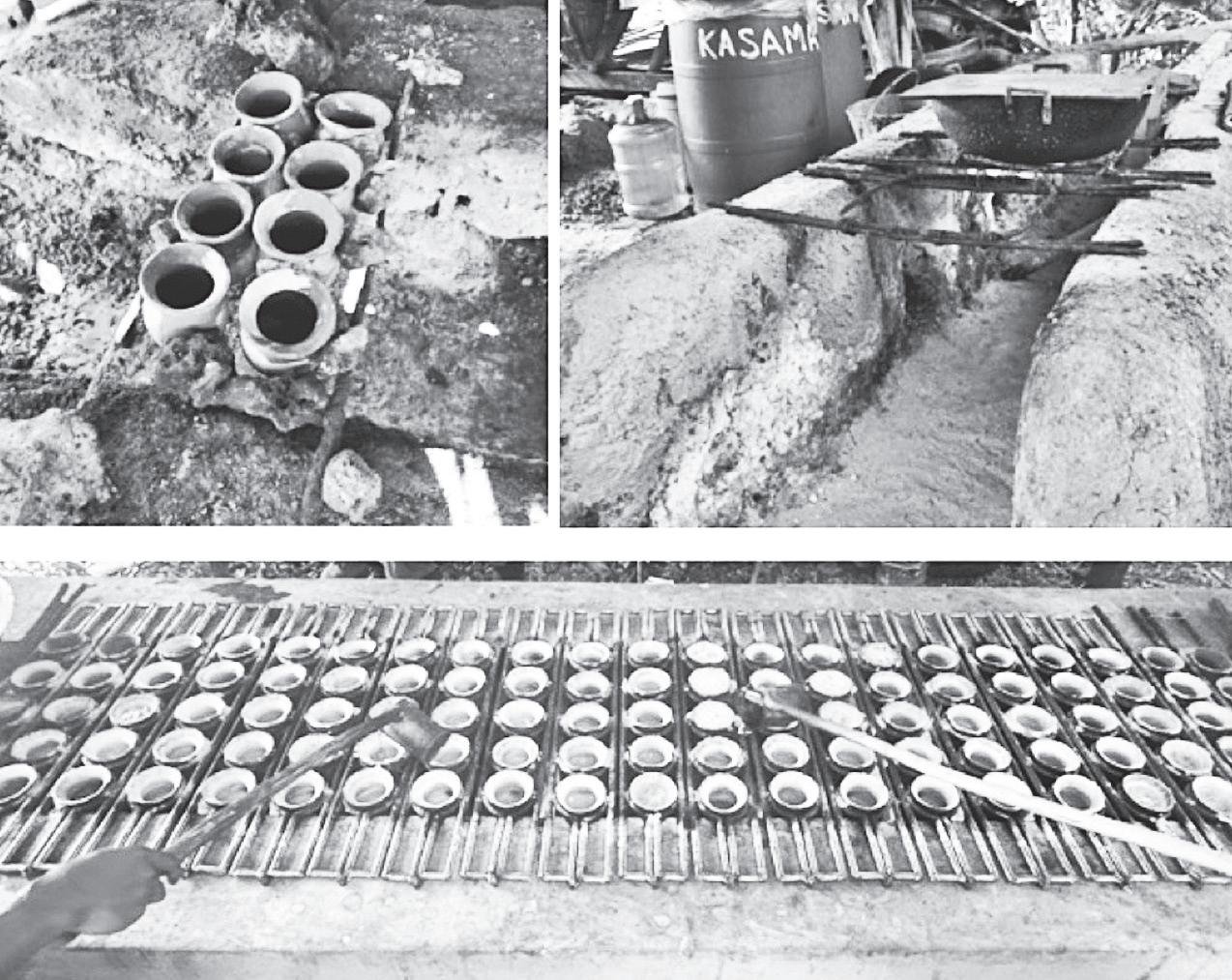
ABy Analyn R. Buslon
Bohol—
LBURQUERQUE,
Produced from seawater through a painstaking multi-step process that dates back to the 17th century, “asin tibuok” is a rare artisanal sea salt, also called “dinosaur egg” for its unique shape. It has been crafted in Alburquerque, Bohol, that it has become a piece of the municipality’s centuries of history.
In the past, asin tibuok was considered a highly valuable good that locals traded it for rice, corn, and other essentials.
But as cheaper, mass-produced table salt became widely available, demand for the artisanal salt declined.
By the 1980s, only a handful of families kept the practice alive, and many feared the tradition would completely disappear.
11 families left to continue the tradition TODAY, only 11 families in Alburquerque make asin tibuok, municipality’s records say, compared to over 100 families centuries ago. Thanks to their perseverance, the flame of asin tibuok did not die.
At the heart of this effort is Manong Non, one of Alburquerque’s most respected elders. Together with the few families, he carried on with the continuation of this laborintensive craft.
In 2019, with the support of Kapunungan sa Mangasinay sa Albur (Kasama), a group dedicated to the making of asin tibuok, the tradition continues to live.
“I have seen how asin tibuok
almost faded away, but I cannot just let go of what I have been doing since I was young. This salt is our story, our heritage. My hope is that people will come to know its value, so that more families can return to this craft and find a livelihood from it. That way, asin tibuok will never be forgotten,” Felix Pinlac Jr., popularly called Manong Non, said in the dialect.
While others turned to easier livelihoods, the few families remained by the fire, shaping pots, boiling seawater, producing salt just as their ancestors had done for generations.
Government’s support WITH the association’s determination to keep their heritage alive and with the full support of Alburquerque local government, the salt makers collaborated with the Department of Science and Technology through its Bohol Provincial Science and Technology Office (DOST VII-Bohol PSTO) to improve some steps in making asin tibuok’s production safer, more efficient, and sustainable.
The craft that’s been passed down for generations is anything but easy.
In their meeting with DOST Bohol Provincial Director Vina R. Antopina, the members of Kasama opened up about the challenges they encounter in producing the artisanal salt.
The process of making the salt begins by soaking, drying and burning coconut husks into ash, which is then used as filter for seawater to create a concentrated brine they call “tasik.”
The brine is boiled in rows of pots, with workers braving exposure from
eight hours to nine hours of intense heat beside the blazing fire.
When the smoke clears, what emerges is a block of salt molded round by the pot, earning the nickname, “dinosaur egg,” owing to its shape.
Making both the traditional and mechanized processes work
WHILE some processes remained untouched to protect the heritage of the traditional salt making, interventions were introduced in other processes.
Among the traditional processes are coconut dehusking and soaking. The dehusking are still done manually using a pointed tip bar.
The husks are soaked in seawater near the mangroves for three to six months to allow the husks to fully absorb salt from seawater, enriching them with minerals.
DOST-VII Bohol supported the mechanization of its other processes, such as slicing and drying. While slicing a single husk with a traditional bolo and a mechanized slicer technically takes almost the same amount of time, the real difference is in the effort.
Manual slicing is exhausting, with the workers having to pause and catch their breath every so often, taking about 30 minutes to slice one basket of coconut husks (around 50 pieces).
With an efficient mechanized coconut husk slicer, the same task can be done continuously at a reduced time of 10 minutes, making it less tiring for the workers.
At the same time, the furnace-type hot air-drying technology with shed, provides the workers protection from extreme weather, and assures them of continuous husk drying.
To honor the heritage of traditional asin tibuok making, the current method of husk firing and brine filtering has been preserved. The husks are continuously fired until white salt-rich ashes, called “gasang,” are formed.
They are then packed into a coneshaped bamboo filter called “sagsag” that is lined with palm leaves, then washed with seawater to draw out concentrated brine tasik. Boiling tasik until it hardens is the most grueling part of asin tibuok making.
Traditionally, Kasama members would stack the clay pots on plain round bars, balancing them with stones over a fragile concrete furnace. The process makes workers endure intense heat as they tirelessly tend the fire, feeding it with coconut wood until salt gradually forms inside the earthen pots.
The introduction of a high-alumina brick furnace has helped contain the fire better, reduced boiling time from 8 hours to 9 hours down to just 5hours to 6 hours, and cut the coconut wood consumption as fuel.
The innovative stainless steel guide trays are sturdier and more heatresistant, which made pot preparation faster and easier.
Kasama member Abundio Manungas recounted how he was exposed to the heat of cooking salt since he was a young boy. He is grateful that the boiling time has been shortened through the upgraded furnace.
With the recent S&T interventions, Manungas’ son was inspired to join the association, and now assists him in the craft of asin tibuok making. Thus, he feels reassured that their heritage will continue.


The asin’s clay vessel
WHILE asin tibuok is the heart of Bohol’s salt-making tradition, the earthenware pot is its vessel. The two are inseparable. Without the clay pots, there can be no asin tibuok—the distinctive salt is shaped when brine crystallizes inside the pot’s curved walls.
To support this tradition, Kasama has been provided with modern materials and innovations in earthenware pot making.
What was once a tedious, timeconsuming task with a wooden paddle, kneading the clay is made easy through the introduction of an efficient clay kneading technology.
Molding the clay, called “pikpik,” is preserved being considered the soul of pot making. Instead of leaving the pots on bare ground, wooden racks are built for a more stable and efficient air drying the freshly molded pots.
Traditionally done in open fires with wood, bamboo, and coconut fronds, or fan-shaped coconut leaves, firing often led to cracked pots and exposed workers to extreme heat.
Shifting to the use of a modern, single-chamber open-fire furnace technology, has made firing more uniform, producing consistent color, fewer cracks, stronger pots and with less environmental impact.
Alburquerque’s last master potter, Junile Paran, has generously shared his expertise with Kasama members on the proper use of the single chamber kiln.
Under Paran’s guidance, Kasama members received hands-on training covering key aspects, such as the proper piling of earthenware pots in the kiln to ensure even
heat distribution throughout the preheating and full firing stages.
After eight hours of firing, the earthenware pots are left to cool slowly inside the kiln overnight, until the pots reach room temperature to ensure optimal strength and quality. Once cooled, they are carefully stored in traditional baskets called “bukag.”
Upside of merging tradition with innovation BY blending heritage and innovation, the Kasama has strengthened both the pot and the salt it holds. The result is more than just increased production. It is the assurance that this cultural treasure will endure, preserving both the community livelihood and ancestors’ legacy.
After some technological interventions, the association’s asin tibuok is currently able to find new markets. One is Coco Berry, a café and delicacies/souvenirs shop in Baclayon.
Another is the Bohol Bee Farm, a renowned resort and restaurant in Dauis that takes pride in organic and homegrown products.
Through these partnerships, more people have come to know and taste asin tibuok, giving new light to its meaning as a treasured heritage.
DOST interventions fall under DOST-Bohol’s Community Empowerment through Science and Technology Program, which supports livelihoods, protects cultural heritage, and empowers vulnerable communities.
DOST Bohol Director Antopina was recently named the Regional Winner and National Semi-Finalist in Gawad Lingkod Bayan ng Pangulo for leading in providing S&T programs to the communities.
ZAMBOANGA CITY—In a country where disaster drills are routine and hazard maps are a necessity, Region IX’s (Zamboanga Peninsula) Regional Science and Technology Week (RSTW) chose to turn the stage into a full-scale blueprint for resilience.
This year, Zamboanga became the center of the Handa Pilipinas Mindanao Leg, the first time the event was hosted in the peninsula. The showcase gathered scientists, local government units (LGUs), and policy leaders to highlight how science and technology can move beyond the exhibit halls.
“This is the first time for us to host the Mindanao Leg of Handa Pilipinas,” said DOST IX Acting Regional Director Jennifer Pidor during the press conference. “We really touch base with our local government units, which is the very essence of Handa Pilipinas, because our LGUs are partners.” Region IX opted to anchor its RSTW entirely on Handa Pilipinas, streamlining every exhibit, talk, and activity around disaster risk reduction and climate change adaptation (DRRM-CCA).
“The focus here is only Handa Pilipinas,” said Science Secretary Renato U. Solidum Jr. “All exhibits are related to disaster. That’s what makes it unique, so people won’t be confused about what they’re seeing and learning.”
Beyond the exhibits BUT the bigger goal, science officials said, is to make sure the lessons outlive the event.
“The very true measure of success of Handa Pilipinas is not just on the number of participants but on the number of partnerships forged,” Pidor said. “If you see earlier, one of the highlights was the 43 LGUs who have adopted Redas already.”
The Redas (Rapid Earthquake Damage Assessment System), developed by Philippine Institute of Volcanology and Seismology (Phivolcs), helps local governments simulate hazard scenarios and craft more targeted response plans.
From 2023 to 2024, data from DOST showed that 74 of 75 LGUs in the Zamboanga Peninsula completed Redas training. Only one remains, Pidor noted, but “they’ve already committed to be trained one-on-one.” The adoption is being

institutionalized. Following the passage of Regional DRRM Council IX Resolution 16, 43 LGUs have passed local ordinances and signed agreements to integrate Redas into their disaster response and emergency preparedness plans. And the shift isn’t limited to
simulations. DOST IX and Phivolcs have begun installing Community Tsunami Alerting Stations in coastal provinces, setting up a Sea Level Monitoring Station in Tabina, and preparing new Earthquake Monitoring Stations in Isabela City and Liloy, Zamboanga del Norte.
During the second quarter Nationwide Simultaneous Earthquake Drill in Dipolog City last June, the region rolled out its Mobile Command and Control Vehicle, a roving hub for communication and coordination during emergencies.
Drone mapping and training programs are also underway, expanding local capacity for real-time monitoring and rapid damage assessment.
“These kinds of engagements are what we want to sustain,” said DOST Undersecretary Sancho Mabborang. “We don’t just come here to celebrate. The idea is to turn these discussions into long-term collaborations, to solve real problems as determined by local leaders.”
Building a smarter Zambo THAT continuity is also visible in grassroots projects.
The Automated Water-Level and Rain Monitoring Using Near-Real Time Observation (ALeRTO) RF Project, developed by Ateneo de Zamboanga University and supported by DOST IX, is developing a decentralized flood earlywarning system using local sensors and servers. Moreover, GeoRisk Philippines, a
multi-hazard risk assessment platform, is now serving more than 1,600 LGUs nationwide. With a few clicks, local planners can access hazard maps and exposure data to guide land use and infrastructure planning. Complementing these are the Meteorological Data Acquisition Station for Information Dissemination (Masid) Technologies, a suite of real-time monitoring tools using automated rain gauges and weather stations; and Project Disaster Narratives for an Experiential Knowledge-based Science Communication Sourcebooks (Danas), a DRRM education toolkit translated into Filipino and local dialects to make science accessible.
There is also the Pagasa National Hydro-Met Observing Network (Panahon), a DOST-Philippine Atmospheric, Geophysical and Astronomical Services Administration’s (Pagasa) online portal for weather forecasts, climate outlooks, and hazard updates. Each tool, Pidor explained, reinforces a shared vision, “that science shouldn’t stay in research papers or exhibit tables, but in the hands of communities who need it most.”
A8 Sunday, October 12, 2025
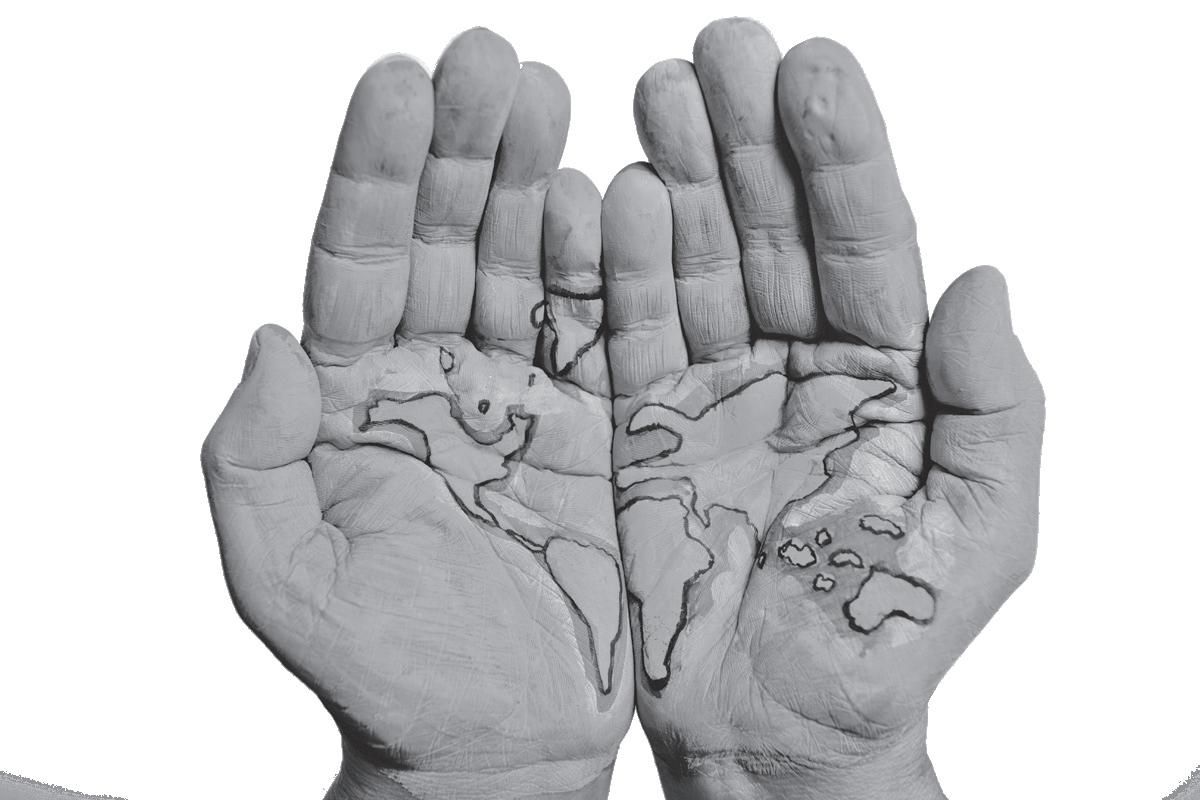
Editor: Lyn Resurreccion • www.businessmirror.com.ph
By Norman Dequia
CARDINAL Jose Advincula of Manila urged Filipinos to rediscover the true meaning of holiness and “normalize sainthood” in everyday life as the Catholic Bishops’ Conference of the Philippines launched its new CBCP Office for the Postulation of the Causes of Saints.
Speaking at the First National Postulation Conference held October 7 at the Pope Pius XII Catholic Center in Manila, he said holiness is not a privilege for a few but a call for all the baptized.
“Let us normalize the idea of sainthood for all, especially among the young people. God did not call the perfect or the ideal—He looked at the heart and the potential,” Advincula said during the “Llamados a ser Santos [Called to be Saints] Postulation Conference 2025.”
The cardinal described the conference as timely and crucial amid the nation’s moral and social challenges.
“It was when times were extremely dark that the Lord called saints to serve as beacons of light amid the decadence and despair,” he said. “We are saints in process, and the Lord is not finished with us yet.” Advincula reminded the faithful that holiness is not measured by perfection or miracles but by love, humility, and service.
“The Lord is calling every one of us to be saints—to proclaim the light and joy of the Gospel in our homes, parishes, and communities,” he added.
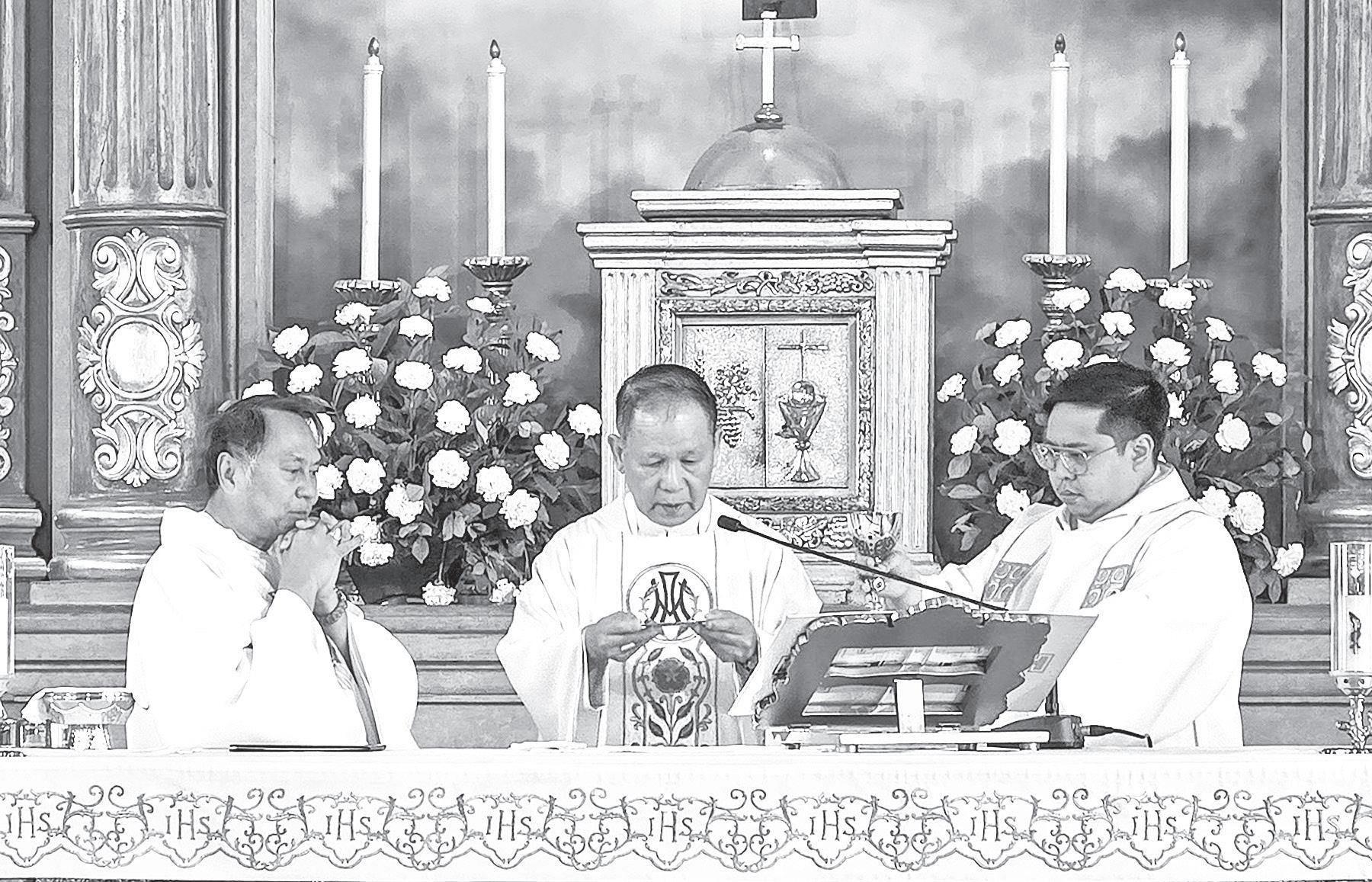
Bishop Renato Mayugba of Laoag, chairman of the new CBCP office, said its mission is to assist dioceses and religious communities in promoting candidates for sainthood and to rekindle public awareness of the universal call to holiness.
“The office aims to help dioceses and communities advance their
POPE Leo XIV commissioned 39 new catechists worldwide, including two Filipinos who devoted years of service to the Church.
Charlita Tabigue of the Diocese of Surigao and Rodina Anonuevo of the Diocese of San Pablo received the catechist ministry during Mass in St. Peter’s Square on September 28. Catechists from Brazil, India, Mozambique, South Korea, England, the United States and other countries each received a crucifix from the pope as a sign of their mission during the three-day Jubilee of Catechists’ closing liturgy.
In his homily, Pope Leo described catechists as “disciples who become witnesses,” saying their mission is rooted in both word and life.
“The name of your ministry comes from the Greek verb katēchein, which means ‘to teach aloud, to make resound,’” the pope said.
“The catechist is a person of the word—a word that he or she pronounces with his or her own life,” he added.
He stressed that the first catechists are parents who transmit faith at home, around the family table.
“Just as we learned our mother tongue, so too the proclamation of the faith cannot be delegated to someone else; it happens where we live,” he said.
Pope Leo also called catechesis a lifelong journey, shared across all stages of life. He pointed to the Catechism as the “travel guidebook” of faith, safeguarding unity against individualism and discord.
“When we teach the faith, we do not merely give instructions, but we place the word of life in hearts, so that it may bear fruits of a good life,” he said.
Tabigue, head catechist of Saint Augustine Parish in Gigaquit, Surigao del Norte, said her journey began three decades ago, inspired
sainthood causes and to make people aware of this universal call to holiness,” Mayugba said.
by her family’s witness of faith and service. Her service started in 1990 when she dedicated herself fully to catechesis, continuing even as a wife and mother of three, balancing parish, family and school commitments.
“At first I thought my family might hinder my service,”Tabigue said. “But with conviction and trust in the Lord, found peace and joy.”
She embraced catechesis as both mission and joy, teaching in schools, leading adult formation programs and mentoring new
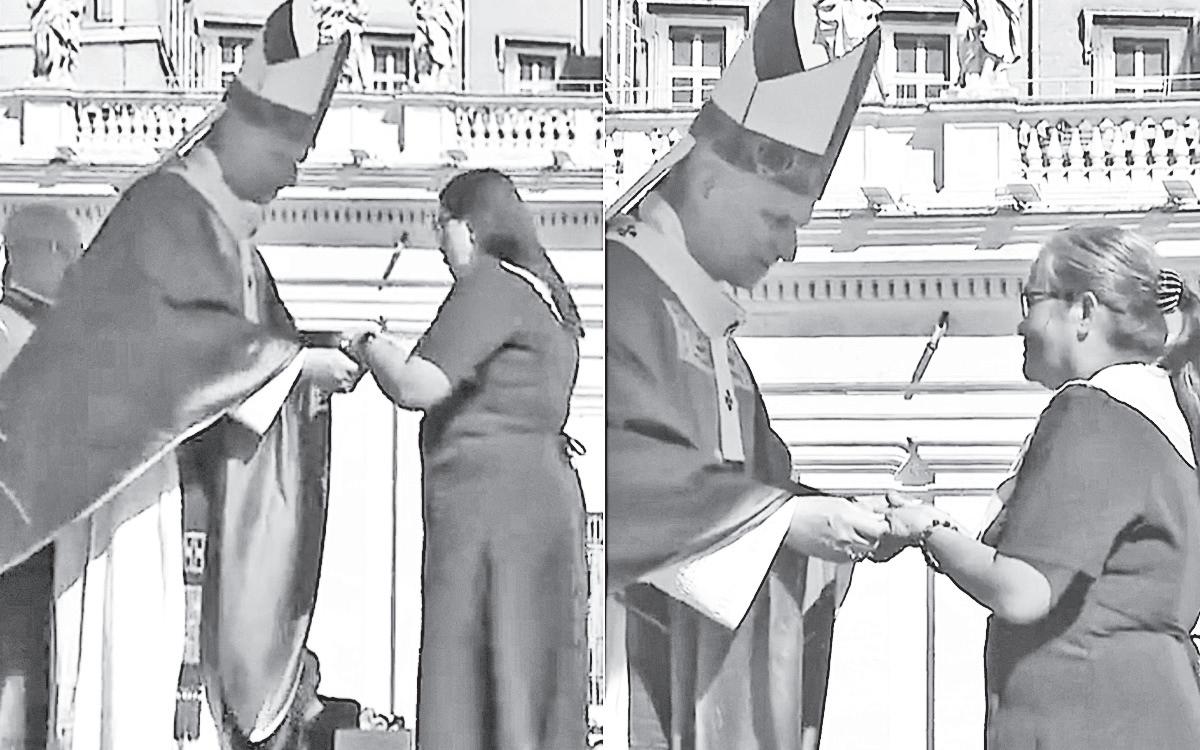
catechists across several parishes in her diocese.
“Through all this, I found true joy even amid difficulties—I find peace in God,” Tabigue said.
Anonuevo, lay coordinator for the Shrine Parish of St. Vincent Ferrer-Mamatid in Cabuyao City, Laguna, traced her vocation to early involvement in faith formation.
She said teaching has always been her passion, which grew stronger after completing a Certificate in Early Childhood Education and serving children in public and private schools.
Now overseeing catechist formation, training, and outreach in her district, Anonuevo said she serves with gratitude, always finding God’s presence in small, everyday acts of kindness.
“Through nearly 14 years in ministry, I’ve learned true impact comes through small actions,” she said. “A simple service, a smile, or a simple thank you—these, too, are expressions of catechesis and evangelization.”
Pope Francis established the lay ministry of catechist in 2021 through the apostolic letter Antiquum Ministerium. He described it as a “stable form of service” and a lifelong vocation of teaching the faith, distinct from temporary catechetical tasks. CBCP News
By Nicole Winfield The Associated Press
VATICAN CITY—Pope Leo XIV has begun correcting some of Pope Francis’ more questionable financial reforms and decisions, canceling a law that had concentrated financial power in the Vatican bank.
Leo abrogated the 2022 law that had decreed that management of the Holy See’s assets was the “exclusive responsibility” of the Institute of Religious Works (IOR).
In his first-ever executive decree, Leo published a new law Monday that says the Holy See generally does use the IOR, but can turn to non-Vatican banks in other countries if the Vatican’s investment
committee “deems it more efficient or convenient” to do so.
The law was the clearest sign yet that Leo is starting to fix some of Francis’ more problematic decisions and is recalibrating the Vatican’s centers of power, after Francis tended to lean heavily on the advice of the IOR and its top manager.
The 2022 law had taken many in the Vatican by surprise since it appeared to contradict the Holy See’s founding constitution. The constitution says the patrimony office, APSA, is responsible for administering the Vatican’s real estate and financial holdings.
Even Francis realized the problem and had intended to fix it, Vatican officials said, but died in April before he could.
IT was the second significant move that Leo has taken in as many weeks to reform some of Francis’ decisions.
On September 27, Leo removed a top administrator in the Secretariat of State and sent him to Paris to serve as ambassador to Unesco.
Msgr. Roberto Campisi had been close to Francis, and the late pope made him president of a new fundraising commission that was formed to drum up donations for the cash-strapped Holy See.
The commission’s statutes and members were announced while Francis was in the hospital, on February 26, and included only Italians with no professional fundraising experience.
The lack of qualified fundraisers and absence of any Americans immediately raised questions about the commission’s credibility. Americans are among the biggest donors to the Holy See, but also demand levels of transparency and accountability that the Vatican hasn’t always followed.
Campisi’s transfer suggests Leo is planning to revamp the commission and perhaps name new members who would lend the commission more gravitas and credibility with key donors.
The new law was announced on the same day that Leo met with the Knights of Columbus, the influential US Catholic charitable organization that is a major donor to the Holy See.
There are currently two canonized Filipino saints—St. Lorenzo Ruiz and St. Pedro Calungsod.
As of today, the Philippine Church has 22 other causes officially recognized by the Vatican’s Dicastery for the Causes of Saints. Of these, seven remain under investigation in the dioceses where the causes were initiated, while 15 are under review by the Holy See, or in what is known as the Roman Phase.
Among those advancing in the Roman Phase are the causes of Venerables Archbishop Teofilo Camomot, Maria Beatrice Rosario Arroyo, Fr. Aloysius Schwartz, Mother Francisca del Espíritu Santo de Fuentes, Sr. Joaquina Mercedes Barceló, Bishop Alfredo Obviar, and Mother Ignacia del Espíritu Santo.
Advincula expressed hope that through the work of the new office, more Filipinos—clergy, religious, and
laypeople alike—will be inspired to live as “saints next door.”
He also dispelled the notion that holiness is reserved for those who perform miracles or live without sin.
“Holiness is a lifelong process of spiritual growth and deepening one’s relationship with God,” the cardinal said. The national conference gathered postulators, diocesan representatives, and members of religious congregations from across the country to strengthen collaboration in promoting Filipino sainthood causes.
Advincula called on the faithful to persevere in their spiritual journey.
“May we raise more Filipino saints—canonized and the ordinary ‘next-door’ saints. May the Lord bless the work that you do. Padayon tayo sa landas ng kabanalan [Let us continue on the path of holiness],” he said. CBCP News
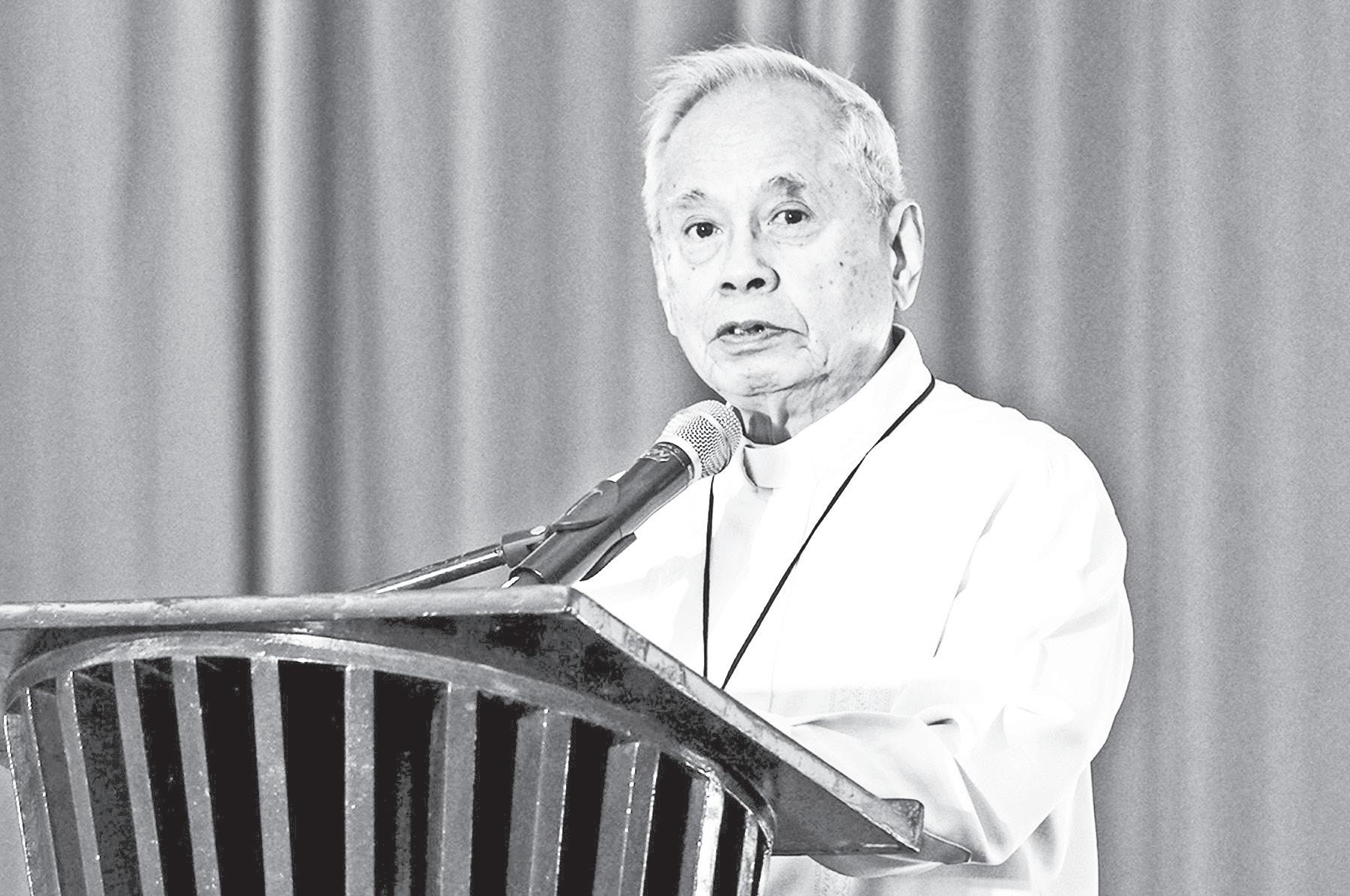
THE government’s peace office has honored Cardinal Orlando Quevedo, archbishop emeritus of Cotabato, for his lifelong mission of “healing divisions and inspiring hope.”
Quevedo, 86, was among this year’s recipients of the Gawad Kapayapaan award of the Office of the Presidential Adviser on Peace, Reconciliation and Unity (OPAPRU).
The cardinal was recognized as the agency culminated the observance of this year’s National Peace Consciousness Month at a hotel in Taguig City on September 30.
He was joined by two other awardees: Maria Veronica Tabara, a former revolutionary leader turned peace advocate, and the provincial government of Basilan.
In his message, Quevedo emphasized that peace is not merely the successful implementation of agreements and laws, but “the presence of mutual trust, respect, and understanding.”
“It is born in the heart,” Quevedo
TALIAN missionary Fr. Sebastiano
ID’Ambra, a well-known peace advocate in the southern Philippines, has been awarded one of Italy’s highest honors.
D’Ambra received the Cavaliere dell’Ordine della Stella d’Italia (Knight of the Order of the Star of Italy), an honor bestowed by the Italian Republic. The award, granted by Italian President Sergio Mattarella, was presented to the priest in Manila by Italy’s ambassador to the Philippines, Davide Giglio, on October 1. The prestigious order of chivalry
recognizes individuals who have significantly advanced friendly relations and cooperation between Italy and other nations, and who promote strong cultural and economic ties with Italy.
In D’Ambra’s case, the recognition honors his lasting commitment to the cause of peace and interreligious dialogue between different cultures in Mindanao.
A priest of the Pontifical Institute for Foreign Missions (PIME), D’Ambra has served in the Philippines since 1977. He has spent most of his missionary life in Zamboanga City, promoting dialogue
between Muslims and Christians through the Silsilah Movement, which he founded. “Silsilah has worked to overcome religious barriers through initiatives of coexistence between Christians and Muslims,” the Italian embassy in Manila said. The initiative, it added, made a significant contribution to the establishment and consolidation of the Bangsamoro Autonomous Region in Muslim Mindanao. The Silsilah Movement has received several national and international peace awards, including the Goi Peace Award in
2013 from Japan’s Goi Peace Foundation, and the World Interfaith Harmony Week Award in 2014, sponsored by King Abdullah II of Jordan. Most recently, in July 2024, D’Ambra received the Bishop Jorge Barlin Golden Cross Award, the highest honor given by the Catholic Bishops’ Conference of the Philippines (CBCP), for his service to the Church.
He also served for many years as executive secretary of the CBCP’s Episcopal Commission on Interreligious Dialogue. CBCP News
said. “Let us continue building bridges—not only between communities, but between hearts—for only together can we truly walk the path of peace.” He dedicated the award to the countless individuals—Muslims, Christians, and Lumads—“who have labored quietly for peace.”
From his early days as bishop of Kidapawan to co-founding the Bishops-Ulama Conference in 1996, OPAPRU said Quevedo has worked to build bridges of understanding, respect, and solidarity among Mindanao’s diverse faith communities.
Now a member of the Bangsamoro Autonomous Region in Muslim Mindanao’s Council of Leaders, the agency said Quevedo continues to play a key role to help address conflict and promote dialogue, justice, and empowerment, the agency said.
“His decades of service to the Church and communities in Mindanao show us that peace is built not only through institutions, but through compassion, unity, and faith in humanity,” OPAPRU said. CBCP News
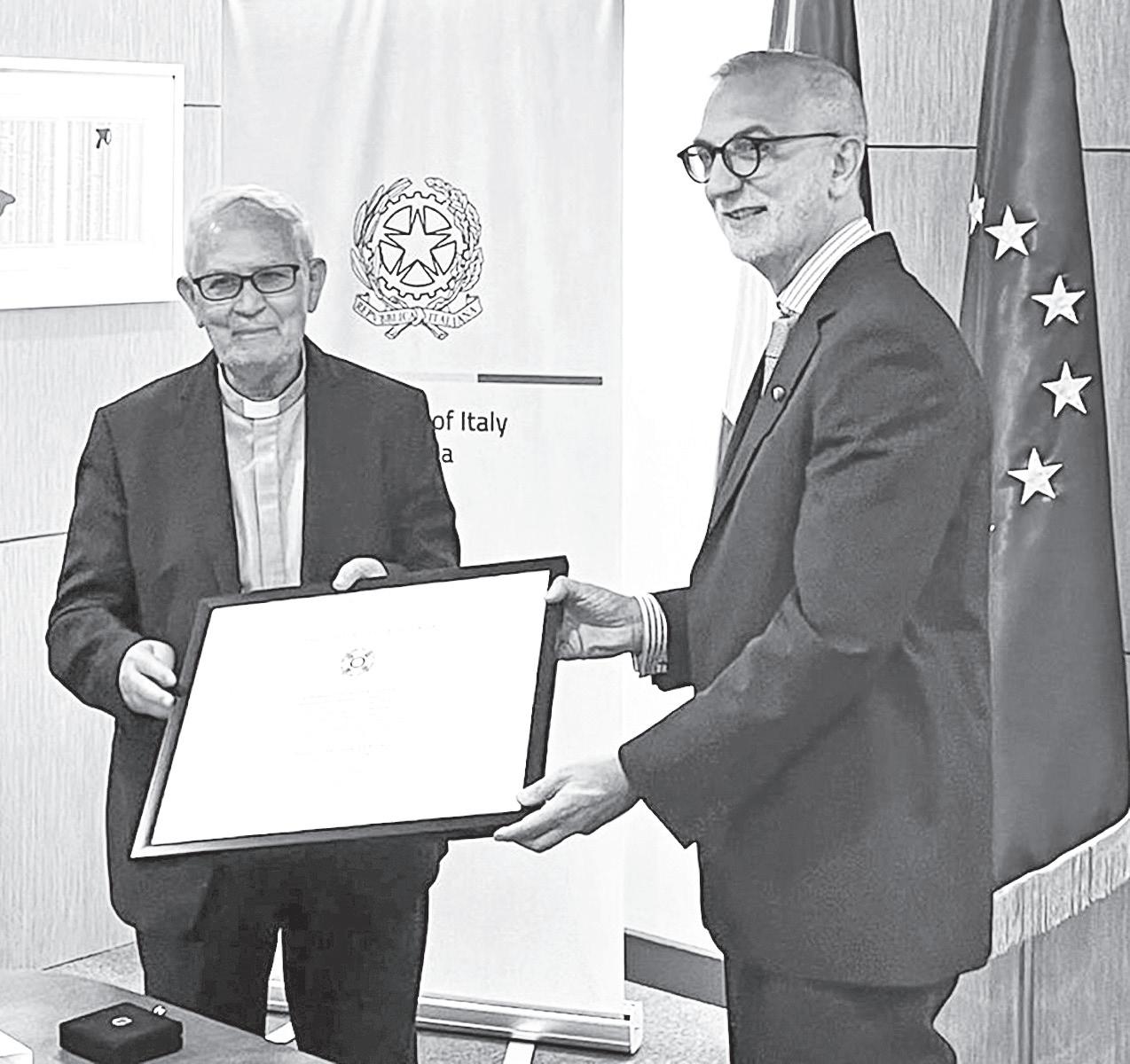

Editor: Lyn Resurreccion

By Tammy Webber
N Indonesian archipelago
Athat’s home to threefourths of Earth’s coral species, a stretch of Icelandic coast with 70 percent of the country’s plant life and an area along Angola’s Atlantic coast featuring savannahs, forests and estuaries are among 26 new Unesco-designated biosphere reserves.
The United Nations cultural agency says the reserves—785 sites in 142 countries, designated since 1971—are home to some of the planet’s richest and most fragile ecosystems.
But biosphere reserves encompass more than strictly protected nature reserves; they’re expanded to include areas where people live and work, and the designation requires that scientists, residents and government officials work together to balance conservation and research with local economic and cultural needs.
“The concept of biosphere reserves is that biodiversity conservation is a pillar of socioeconomic development” and can contribute to the economy, said António Abreu, head of the program, adding that conflict and misunderstanding can result if local communities are left out of decision-making and planning.
The new reserves, in 21 countries, were announced in Hangzhou, China, where the program adopted a 10-year strategic action plan that includes studying the effects of climate change, Abreu said.
Biodiversity hot spots
THE new reserves include a 52,000-square-mile (135,000-square-kilometer) area in the Indonesian archipelago, Raja Ampat, home to over 75 percent of earth’s coral species as well as rainforests and rare endangered sea turtles. The economy depends on fishing, aquaculture, small-scale agriculture and tourism, Unesco said.
On Iceland’s west coast, the Snæfellsnes Biosphere Reserve’s landscape includes volcanic peaks, lava fields, wetlands, grasslands and the Snæfellsjökull glacier. The 1,460-square-kilometer (564 square-mile) reserve is an important sanctuary for seabirds, seals and over 70 percent of Iceland’s plant life—including 330 species of wildflowers and ferns. Its population of more than 4,000


people relies on fishing, sheep farming and tourism.
And in Angola, the new Quiçama Biosphere Reserve, along 206 kilometers (128 miles) of Atlantic coast is a “sanctuary for biodiversity” within its savannahs, forests, flood plains, estuaries and islands, according to Unesco. It’s home to elephants, manatees, sea turtles and more than 200 bird species. Residents’ livelihoods include livestock
herding, farming, fishing, honey production.
Collaboration is key RESIDENTS are important partners in protecting biodiversity within the reserves, and even have helped identify new species, said Abreu, the program’s leader. Meanwhile, scientists also are helping to restore ecosystems to benefit the local economy, he said. For example, in the Philippines,
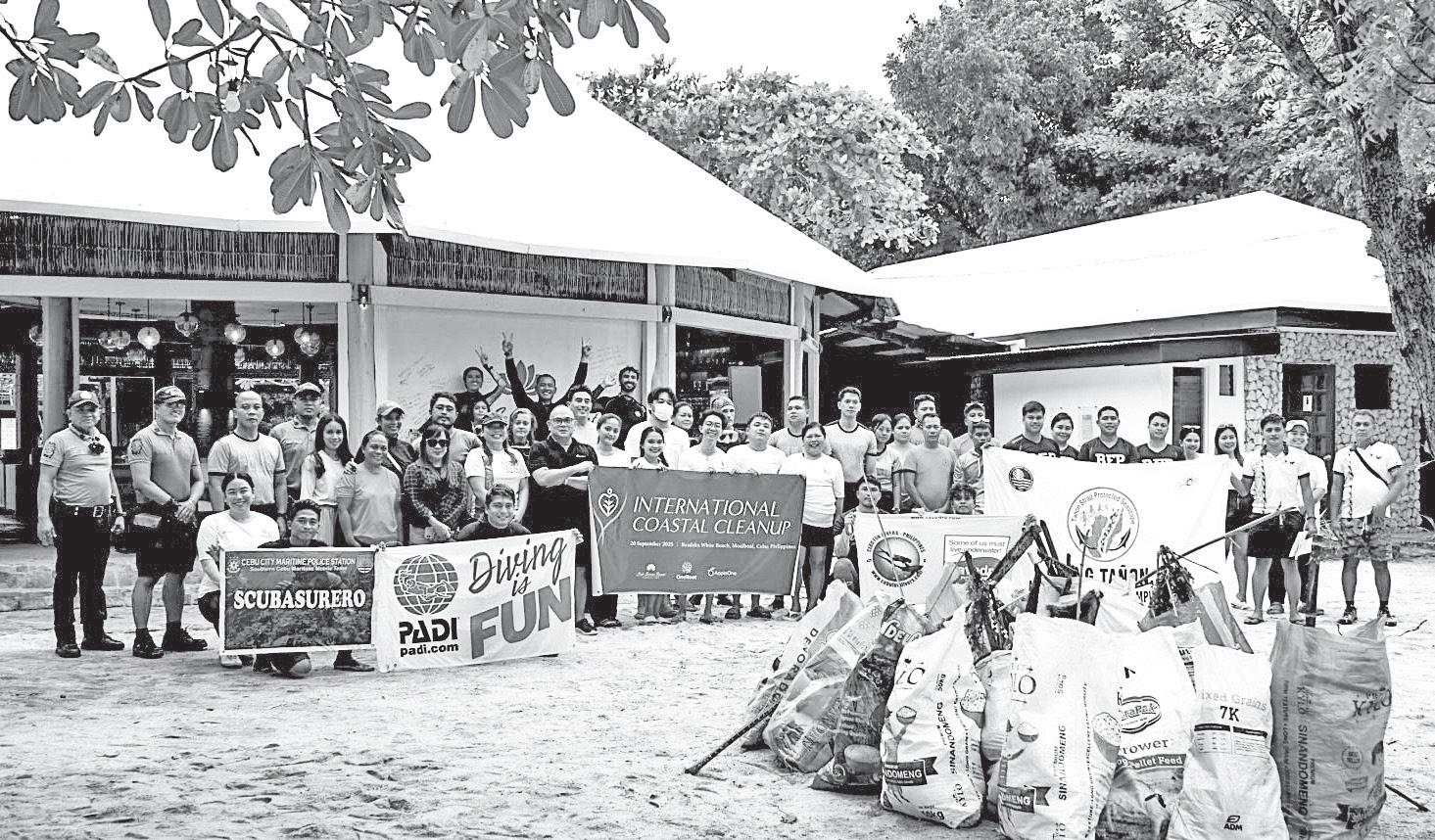
& photos
Story
by Bernard L Supetran
LUB Serena Resort, an upscale beach hotel in Moalboal, Cebu province, led the recent International Coastal Cleanup (ICC) Day along the Tañon Strait, one of the top beach and dive destinations in Cebu. Held at the famed Basdaku Beach in Bgy. Saavedra, the environmental event is the town’s first private sector-led multi-sectoral and collaboration with 105 participants from the municipal government, public safety officers, and tourism stakeholders, who hauled 200 kilos of trash.
The ICC—held annually on the third Saturday of September— was introduced in 1986 by the Texas-based Ocean Conservancy, and has since gained global popularity around the world, including the Philippines, which boasts of hundreds of thousands of participants nationwide.
Volunteers included employees of AppleOne Properties Inc. (API), Barangay Saavedra officials, personnel from the Philippine National Police, Philippine Coast Guard, Bureau of Fire Protection, Department of Environment and Natural Resources, and Moalboal Municipal Tourism Office, owners of beach establishments, and One Root Hospitality, which owns and operates Club Serena.
Moreover, scuba divers from Savedra Dive Center, Cebu Fun Divers and 7 Seas Dive Center did
underwater cleanup.
“Club Serena’s leadership in this year’s ICC is our public statement on sustainability even as we pursue property and tourism development in the countryside,” says API Vice President for Hospitality Samantha Manigsaca, who hatched the local version of the global movement.
“Our mother company, AppleOne Properties Inc., has been implementing earth-friendly measures across our group of companies, and the ICC is part of our bigger journey towards corporate social responsibility and sustainable tourism,” Manigsaca adds.
She noted that the multi-sectoral participants wrote specific pledges after the cleanup to create synergy for Tañon Strait, which AppleOne and Club Serena will help take to the next level of environmental
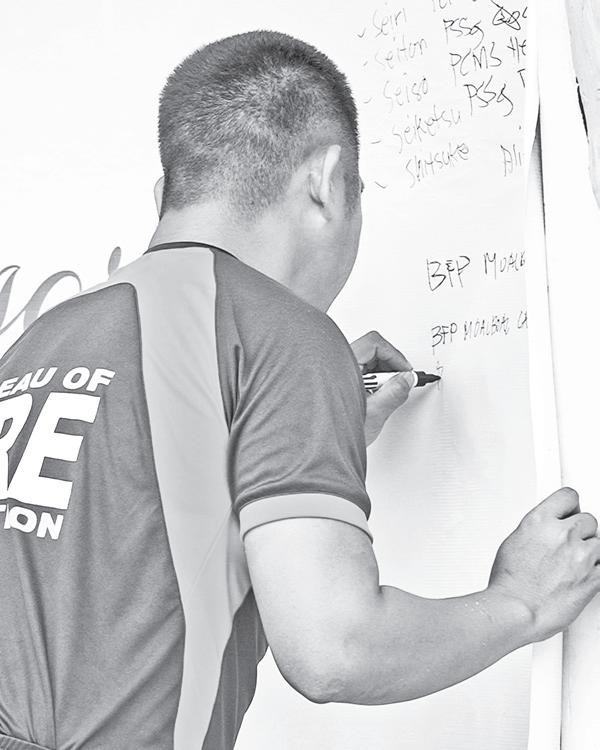
advocacy in the coming years.
The third Saturday of September has been declared in the Philippines by Presidential Proclamation 470 in 1994 as the International Coastal Cleanup Day enjoining government agencies and sectoral organizations.
This year’s theme is “Clean Seas Against the Climate Crisis, Tayo ang Solusyon [We are the Solution],” which highlights the need to sustain the coastal and marine ecosystems as the natural shields to extreme weather conditions.
Regarded as the country’s biggest protected seascape, which is known for its rich marine and terrestrial biodiversity, Tañon Strait is a 160-kilometer long body of water located between the provinces of Cebu, Negros Oriental, and Negros Occidental, embracing 42 municipalities and cities.
It has a spread of 8,408 hectares
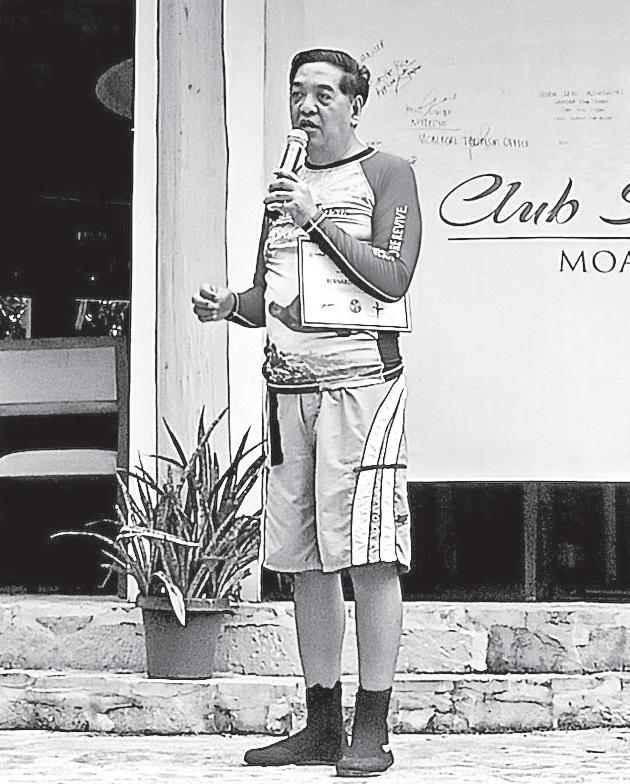
of coral reefs with 41 common coral genera, 4,108 hectares of mangrove forests with 46 known species, and is habitat to nearly half of the archipelago’s cetaceans, and 12 of the country’s 16 seagrass species.
It is also home to the sardine run, a world-famous dive site because of the thousands of sardines swirling near Panagsama Beach and Pescador Island, a limestone islet which has been declared a marine park and fish sanctuary.
A simultaneous public sector cleanup was also held in the coastal areas around the town proper led by Moalboal Mayor Inocentes Cabaron and municipal government officials and civil servants.
“The annual ICC Day brought together people from all walks of life to care for the sea and celebrate our love for nature and culture,” says the local chief executive.
He noted that public and private entities do regular coastal and underwater cleanups which involve the townsfolk, fisherfolk, and all tourist stakeholders to ensure environmental health of Moalboal and their portion of Tañon Strait. Cabaron added that this year’s event is a part of the town’s yearround commitment to protecting one of the country’s best beaches and underwater world.
Located along Cebu’s southwestern corridor,
the coral reefs around Pangatalan Island in Palawan were severely damaged because local fishermen used dynamite to find depleted fish populations.
Scientists helped design a structure to help coral reefs regrow and taught fishermen to raise fish through aquaculture so the reefs could recover.
“They have food and they have also fish to sell in the markets,” said Abreu.
In the African nation of São Tomé and Príncipe, a biosphere reserve on Príncipe Island led to restoration of mangroves, which help buffer against storm surges and provide important habitat, Abreu said.
Ecotourism also has become an important industry, with biosphere trails and guided bird-watching tours. A new species of owl was identified there in recent years.
This year, a biosphere reserve was added for the island of São Tomé, making the country the first entirely within a reserve.
Climate and environmental concerns
AT least 60 percent of the Unesco biosphere reserves have been affected by extreme weather tied
to climate change, which is caused primarily by the burning of fossil fuels such as coal and gas, including extreme heat and drought and sealevel rise, Abreu said.
The agency is using satellite imagery and computer modeling to monitor changes in coastal zones and other areas, and is digitizing its historical databases, Abreu said. The information will be used to help determine how best to preserve and manage the reserves.
Some biosphere reserves also are under pressure from environmental degradation.
In Nigeria, for example, habitat for a dwindling population of critically endangered African forest elephants is under threat as cocoa farmers expand into Omo Forest Reserve, a protected rainforest and one of Africa’s oldest and largest Unesco Biosphere Reserves. The forest is also important to help combat climate change.
The Trump administration in July announced that the US would withdraw from Unesco as of December 2026, just as it did during his first administration, saying US involvement is not in the national interest. The US has 47 biosphere reserves, most in federal protected areas. AP

ASTSOUND,
Researchers
orca—known
N(10
MVP Shai Gilgeous-Alexander of Oklahoma
(8 percent), and Victor Wembanyama of the San Antonio Spurs (7 percent).
Top four playoff seeds
IF the GMs are to be believed, the top four playoff seeds in the Eastern Conference will be, in order, Cleveland, New York, Orlando and Atlanta.
In the West, Oklahoma City was followed by Denver, Houston and Minnesota.
Best at their position SHAI GILGEOUS-ALEXANDER (73 percent) was the runaway pick as best point guard, with Minnesota’s Anthony Edwards (70 percent) the top pick at shooting guard, Nikola Doncic (40 percent) the best small forward, Milwaukee’s Giannis Antetokounmpo (93 percent) the top votegetter at power forward and Jokic (97 percent) was the pick of almost everyone at center.
The Nuggets couldn’t vote for Jokic; by process of elimination, that means Denver’s vote for best center likely went to Wembanyama, since he was the only other player to receive a vote as the best center. And the best pure shooter was nearly unanimous: Golden State’s Stephen Curry (93 percent) got almost all votes, with his former Warriors teammate Klay Thompson—now with Dallas—getting the other 7 percent.
Curry was also the pick as best leader, and the player GMs would want taking the shot with the outcome of a game hanging in the balance.
Most improved team
THE GMs expect to see big jumps from Orlando (47 percent) and Atlanta (20 percent), making those clubs two of the top three votegetters when asked which team will be improved the most this season.
San Antonio tied Atlanta, getting 20 percent of the voting.
Rookie of the year
TO no surprise,
Spoelstra top choice as US head coach for Qatar, LA?
ERIK SPOELSTRA of the Miami Heat has emerged as the choice to become the next coach of the US men’s basketball team for the 2027 World Cup in Qatar and 2028 Los Angeles Olympics, two people with knowledge of the situation said late last week.
Spoelstra and USA Basketball have yet to completely finalize any agreement, said the people, who spoke on condition of anonymity because no public announcement has been scheduled. Such moves typically follow USA Basketball board of director meetings and one of those is set for later this month. Spoelstra would be replacing Steve Kerr, who coached the Americans in the last Olympic cycle and led the team to a gold medal at the Paris Games.
The US men have won the last five Olympic gold medals and Spoelstra was on the staff that won in Paris last summer.
He told The Associated Press after
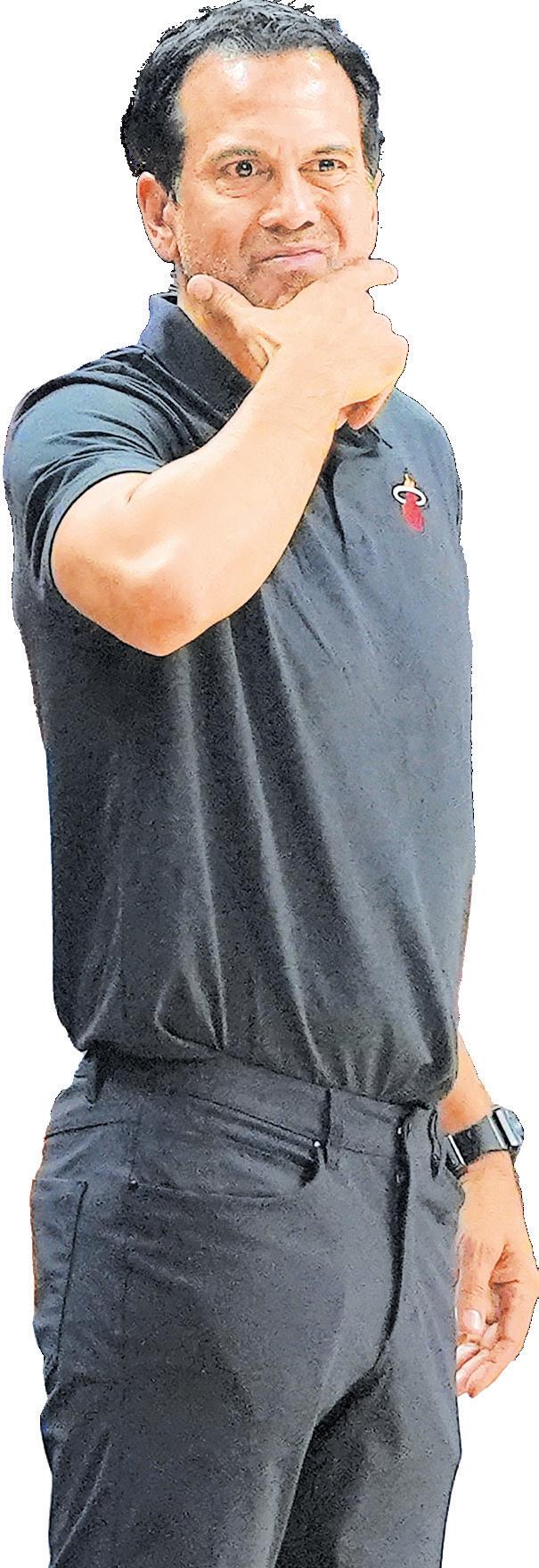
No. 1 pick Cooper Flagg of Dallas was the choice to win rookie of the year—he got 97 percent of the vote, likely meaning 29 of the 30 if all teams submitted an answer.
The only other player to get a vote was Philadelphia’s VJ Edgecombe (3 percent).
Best defensive player AGAIN, no surprise: Victor Wembanyama got 80 percent of the vote, with Minnesota’s Rudy Gobert and Cleveland’s Evan Mobley (7 percent) a distant second.
Wembanyama was widely picked as the favorite to win defensive player of the year last season before he was shut down in February following a diagnosis of deep vein thrombosis.
Spoelstra Best coach ERIK SPOELSTRA once again was picked as the best coach in the league, getting 52 percent of the vote. Oklahoma City’s Mark Daigneault (34 percent) was second.
Spoelstra was the narrow choice as best manager or motivator of people as well, his 28 percent of the vote there barely edging Houston’s Ime Udoka (24 percent), Golden State’s Steve Kerr (14 percent) and Boston’s Joe Mazzulla (14 percent). AP
the gold-medal game in Paris that he “would be honored” if USA Basketball asked him to take over the program.
Spoelstra would also become the first Heat coach to have the distinction of being the Olympic coach.
The move comes not long after USA Basketball finalized an agreement to make Duke coach Kara Lawson the coach of the women›s national team for the Olympic cycle through the Los Angeles Games.

Spoelstra will be part of a brain trust that includes men’s managing director Grant Hill, national team director Sean Ford and others that assembles the next national team—which could feature considerable turnover from the team that won gold in Paris.
Kevin Durant, the only fourtime gold medalist in men’s Olympic basketball history, hasn’t ruled out playing one more time in 2028. Stephen Curry indicated that the Paris Games would be his one and only Olympic run, and LeBron James will be 43 when the Los Angeles Games are held.
Miami’s Bam Adebayo, Boston’s Jayson Tatum, Dallas’s Anthony Davis and Phoenix’s Devin Booker, all previous gold medalists, would all likely have strong chances to play in 2028 if they’d like to wear the national team jersey again. There also will likely be some first-time selections for the Olympic team, with Orlando’s Paolo Banchero, Detroit’s Cade Cunningham, Oklahoma City’s Chet Holmgren and Dallas rookie Cooper Flagg sure to be among those under consideration.
Spoelstra—whose father, Jon Spoelstra, was an NBA executive with Portland, Denver and New Jersey— was a standout high school guard in Oregon, then played at the University of Portland, where he was the West Coast Conference’s freshman of the year. AP

LAURA YOUNGSON didn’t expect to focus so much on soccer cleats when she organized a group of women to climb Mount Kilimanjaro and play a high-altitude match. The point of the 2017 game was to highlight inequality in sports for women and girls. On that front, Youngson achieved her goal with the match becoming the subject of a documentary and landing the group in the Guinness Book of World Records.
Still, something bothered Youngson as the match unfolded. Glancing at the athletes’ feet, she was struck that all the women were wearing men’s or boy’s soccer cleats instead of gear that was designed specifically for them. The realization led her to launch IDA Sports, which makes soccer cleats for the unique athletic needs of women.
“There was this real commercial gap for performance footwear for women,” said Youngson, whose IDA cleats are worn by players including Washington Spirit midfielder Courtney Brown. “As the game is growing, we’re in this moment when everything’s professionalizing, but the footwear wasn’t really keeping pace, so I wanted to go and change that.”
IDA is among a growing number of companies founded in recent years to prioritize women in sports.
These aren’t just lifestyle or athleisure brands. Moolah Kicks, for instance, makes women’s basketball shoes designed specifically for women’s feet and counts


NEW YORK—Angel Reese is getting a pair of wings.
The Chicago Sky star announced on Instagram that she will be walking in the upcoming Victoria’s Secret Fashion Show on October 15.
It will be the first time a professional athlete will walk the runway in the show.
“Stepping into a dream: From Angel to a Victoria Secret ANGEL,” the 23-year-old Reese posted on Instagram. “I’m finally getting my wings I’ll be walking the Victoria’s Secret 2025 runway show for the first time, and it feels like destiny. Wings on, heels ready…Catch me on the runway.”
The retailer posted a video on Instagram of the announcement showing the Women’s National Basketball Association player in a pink robe, black lingerie and white feather wings.
“Angel Reese, welcome to the runway. The first professional athlete angel…major is an understatement,” the post reads.
The lingerie show began in 2001 and took place annually for nearly two decades. Victoria’s Secret canceled the show in 2019, but brought it back last year, with Reese attending. AP



TWO DECADES OF PLAY: How the Filipino gaming culture leveled up in the last 20 years
OCTOBER 12, 2025 | soundstrip.businessmirror@gmail.com
Story by Ica Hontiveros-Cheng
David Archuleta is no stranger among Filipinos, back in 2012 he signed a contract with TV5 to shoot the prime-time mini series “Nandito Ako” which ran from February to March 2012. The mini series even had David speaking in Tagalog. Archuleta then released Forevermore- an album which contains covers of classic Filipino songs, this came out in March of the same year.
With a new lease in life after leaving his former church, Archuleta is discovering his own queer identity which we can hear in his new music through his new EP, Earthly Delights which was released last August. Archuleta is making his way back to the Philippines with a scheduled concert on November 21, he is set to perform at the Mall of Asia Arena with Vanessa Carlton and English boy band Blue for the Playback Musical Festival.
Dressed in a green plaid shirt with an aquamarine pendant on, David sat down for an online roundtable

Publisher :
T. Anthony C. Cabangon
Editor-In-Chief :
Lourdes M. Fernandez
Aldwin M. Tolosa
Concept :
Y2Z Editor :
SoundStrip Editor : Group Creative Director : Graphic Designers :
Jt Nisay
Edwin P. Sallan
Eduardo A. Davad
Niggel Figueroa
Chow Jarlego
Contributing Writers :
Tony M. Maghirang
Rick Olivares
Jingo Zapata
Reine Juvierre S. Alberto
John Eiron R. Francisco
Ica Hontiveros-Cheng
Ana Zoe V. Davad
Justine Xyrah Garcia
Ginger Franz S. Ocampo
Trixzy Leigh Bonotan
Bless Aubrey Ogerio
Photographers :
Bernard P. Testa
Nonie Reyes
Y2Z & SOUNDSTRIP are published and distributed free every Sunday by the Philippine Business Daily Mirror Publishing Inc. as a project of the
The Philippine Business Mirror Publishing, Inc., with offices on the 3rd Floor of Dominga Building III 2113 Chino Roces Avenue corner
Dela Rosa Street, Makati City, Philippines. Tel. Nos. (Editorial) 817-9467; 813-0725. Fax line: 813-7025
Advertising Sales: 893-2019; 817-1351,817-2807. Circulation: 893-1662; 814-0134 to 36. www.businessmirror.com.ph
with media from the Philippines to talk about his new EP, Earthly Delights which also released a Deluxe edition (with two new songs and acoustic and remix versions from the original release) and is now available to stream on digital platforms.
For Earthly Delights, what was the creative direction that you took for the EP and was there a particular theme that you had in mind when curating the songs that made it in the EP?
The goal was just to experience life, the sensory experience of life. I think that I’ve lived my life up until recently, very like in my head, like in my thoughts, David raises his index finger to his forehead as he says this.
Rather than feeling things, I was thinking it through like: Okay these are the rules, this is what you follow, this is what you’re supposed to do. This is not what you’re supposed to do. And rather than say well what do you think? Or how do you feel about it David? I always replaced it with: Well, this is what it’s supposed to be, this is how I’m supposed to think. And now I ask myself: Well what do I feel? Like how does it feel to touch someone’s skin?
I love food. That’s why I wrote “Crème brûlée” (the album’s lead single) -it’s a metaphor of the sweetness that I could now experience and feel with dating and human relationships and interactions and the sensuality with connecting with other people.
It’s like getting to experience the sensual part of life, something that is so new to me, but exciting.
What was it like working on this EP as compared to your previous releases?


For my first album it was like-I felt like I was a deer in the headlights. Like what was happening? This is all new, but this is exciting. I wasn’t really telling much of my story, I was just living in the moment.
The second album (The Other Side of Down) was very in my head (he places the tips of both his index fingers on his forehead) -like introspective, I don’t know where I’m going, I’m kind of lost, kind of confused, but I’m still going to do my best to keep moving forward and figure things out. Postcards in the Sky (6th studio release, which came out in 2017) was more reflective, I had just gone on my two-year mission (in Chile). Therapy Sessions (8th studio album, which was released in 2020) -I don’t understand what’s going on, I need to take a break to figure out why I’m so distraught and messy and disorganized and hopeless.
And Earthly Delights is kind of like, well I’ve come to embrace and accept myself, and it’s still not perfect but I’m okay with the messiness of life, and making mistakes, and it feels so good, it’s like finally sitting in that, sensuality and my sexuality. And also, just being confident and comfortable in my own body. So I’m very excited for the music that’s to follow because I’m working on (new music) and I had a writing session yesterday and it’s kind of fun to feel empowered.
In the song “Can I Call You?” there are lyrics that go “it’s more than a crush.” Is this a nod to your song “Crush” and was this something that you intentionally included in the song as a treat for long time fans?
“You got it!” David said laughing. “Yeah- for me it was like the next chapter of ‘Crush’ coz you’re like: I don’t know if this is real, are we just friends? Like we keep getting these feelings and can I call you? It’s like-I’m going for it now. (The song is saying) I want to build something with you, and it’s not always easy especially when you’re travelling on the road, or you’re not near the person, coz of travelling. For me it’s like- it’s the sweetness but it’s also done in a sexy way, a smooth way. I feel that that song captures the most overall of how
David looks inside, coz it’s not trying too hard, it feels effortless and smooth and it has a good groove to it, there’s a sexyness to it but also a sweetness to the song as well.
Having had the opportunity to speak to David twice, I can tell that he is in a good place now, he is having fun discovering and enjoying his own sexuality and identity and you can hear it in his new music. Songwriters and singers write and sing songs about a lot of things, but when it is their own stories and feelings it really resonates, and yes, this also includes giving into indulgence, you have long denied yourself, and in that indulgence comes an infectious confidence, you may not have known was there all along.
‘Earthly Delights’ is now available to stream on digital platforms. David Archuleta returns to the Philippines to perform at the Playback Music Festival (alongside Vanessa Carlton and Blue) on November 21 at the Mall of Asia Arena.

Story by Justine Xyrah Garcia
What started as a casual collaboration between Gloc-9 and Abaddon quickly grew into Project A—a nine-track collaboration that unites two distinct voices in Filipino rap, built on discipline, mutual respect, and creative trust.
What began as a casual idea for just two songs evolved into a cohesive album built on mutual respect and creative trust.
In a press conference with BusinessMirror’s SoundStrip and other media organizations, the two artists shared how Project A took shape from what was initially a simple exchange of beats and verses.
Abaddon recalled how the project started in a group chat with Gloc-9 and producer Cursebox.
“Then Master (Gloc-9) suddenly messaged me and said, ‘Let’s continue this.’ So I immediately sent him some of my best tracks, and from there, things just kept going,” he said in Filipino.
For Gloc-9, the timing was right. After years
of steady releases, he admitted that Project A gave him a needed push to start writing again.
“I was at a point where I was also looking for inspiration to write,” he said. “With the help of artists like Venzon (Abaddon), I slowly found my rhythm again.”
Set for release on October 17—the eve of Gloc-9’s birthday—Project A features tracks such as “Umbag,” “Bonethugs,” and “Kakampi,” featuring Hero.
A collaboration that pushed both artists
While Project A carries both their initials, the album’s creation was less about merging styles and more about pushing boundaries.


Abaddon, long known for his rapid-fire flow and lyrical ferocity, experimented with melody and more personal themes.
“This isn’t the usual Abaddon sound, like the ones I used to make before. I really experimented with more melodic parts—it’s not just rap anymore. I challenged myself because this was a rare chance to work with Master (Gloc-9), so I gave it my best,” he said.
For Gloc-9, who has long set the standard for storytelling in local hip-hop, the project offered a much-needed jolt.
“If it were just me, you’d probably already have an idea of what to expect from the album. But because there’s that Abaddon factor, even I get surprised…When I listen to it, it’s like hearing a new artist. It’s very refreshing for me, and I’m really thankful,” Gloc-9 said.
That mutual respect comes through in “Ambag,” which features Abaddon’s group Shockra and also pays tribute to their late member Inozent One.
Gloc-9 said it was one of those rare songs that wrote itself.
“There are songs that feel like assignments,” he said. “But this one was a magic moment. I think it came together easily because our intention was clear. You know exactly why you’re writing it, and who it’s for.”
Following “Ambag” are two songs that expand Project A’s emotional tone— “Bonethugs” and “Kakampi.”
The album’s emotional throughline continues with “Bonethugs” and “Kakampi.”
The former takes on the familiar tension of relationships—the arguments and reconciliations that come with real love—while the latter turns that emotion into partnership.
Together, the tracks capture how both rappers balance authenticity and heart without losing their sharpness. Each song reflects what they describe as the album’s “good vibes”
core—music grounded in real stories, free of pretense, and built on honesty.
Lessons from each other
More than a collaboration, Project A became a learning exchange. Abaddon said working with Gloc-9 taught him the value of consistency and time.
“Master is really disciplined when it comes to time…I’ve started carrying that discipline with me, even in the projects I’m doing next.” he said.
Gloc-9, meanwhile, said the project reminded him that growth never stops, no matter how long one has been in the game.
“I learned that you still have to trust yourself,” Gloc-9 said. “There are songs on the album that, when I listen to them now, don’t even sound like something I wrote. Maybe that’s because Abaddon’s writing pushed me in new ways. It made me realize you can’t ever think you know everything.”
Both artists also reflected on how technology and artificial intelligence (AI) are reshaping the music scene.
Gloc-9 said he prefers to keep his process rooted in instinct rather than innovation.
“I don’t rely too much on new technology. Maybe in production, yes, but when it comes to writing, I still do it the old way. As long as we’re secure in our artistry, we’re safe,” he explained.
Abaddon agreed, saying that while technology may make songwriting easier, it can never replace lived experience.
“I think it’ll become much easier to make songs,” he said.
“Maybe five or ten years from now, people will just say what kind of track they want, and the lyrics will come out right away. That’s how it’ll be in the future. But for us, we’re not used to that. I think for the next generation of rappers, it’s going to be really easy—too easy—to make songs.”
By Patrick Villanueva
FROM arcades, computer shops, to smartphones, gaming has been quite a phenomenon for Filipinos over the years.
There once a time when video games in these parts were largely frowned upon. It was dismissed as a something that does not amount to anything, a waste of time, an addiction. Yet, today, even the moms and aunts who hurled these labels are spending hours on end glued to their screens. Candy crush, anyone?
Here, we look back on what the last 20 years has been for the realm of video games in the Philippines.
Level 1: The 2000’s REMEMBER feeling excited about going to a local arcade to play Tekken with your friends? Or maybe have an intense race with them on Top Gear 2? Those were the good ol’ days of the 2000s.
Other titles that dominated then were Pacman, Initial D, and House of the Dead; Contra, Metal Slug, and God of War I & II. Teens and children would also frequent Y8.com , a website with a huge collection of free games from fighting to dress-ups.
Not to be outdone were PC gamers, who spent hundreds, if not thousands, of hours on Ragnarok, Cabal, Gunbound, and Audition Online. Meanwhile, Defense of the Ancients or DOTA, a multiplayer online battle arena or MOBA; and, Counter-Strike (CS) the revolutionary first-person, multiplayer shooting game Counter-Strike, laid the foundation of the early eSports scene in the Philippines.
Level 2: The 2010’s OF COURSE, gaming is not a stranger to scrutiny, especially in the 2010’s when the PC gaming culture took a massive leap as an online, multi-player machine.
While console games were still huge in the country, it did not get the same stature as PC gaming. With titles like DOTA and CS having their second installments (DOTA 2 and CS:GO), and other games such as League of Legends, Crossfire, Minecraft, and Grand Theft Auto, PC gaming dominated the scene by a mile. Without a doubt, DOTA was the biggest among them all in the Philippines, even having a song dedicated to it that was a staple in computer

shops nationwide, “Dota o Ako.”
Perhaps the biggest contributor to the success of PC gaming was the Lan (local) tournaments hosted by big organizations and, sometimes, local computer shops.
by Bong R. Osorio, it said that, on average, “Filipino schoolchildren now watch less TV and spend more hours using gadgets to watch YouTube videos, Facebook and playing video games.” It was also men-
‘Perhaps the biggest contributor to the success of PC gaming in the country was the Lan (local) tournaments.’
The trend popularized Mineski, an eSports team that became SEA’s largest eSports organization, and eventually having their own internet cafe chain in the country. Brands like Netopia and TNC followed suit, breeding a fan culture that also paved the way for the content creators to shine. Big names include Alodia, Razzie Binx, 2Staxx, Gloco, and Suzzysaur, to name a few.
The popularity also changed how children consumed online content. In a BusinessMirror report dated in 2019, titled “How the Filipino child consumes media”
tioned that Role-Playing Games (RPG) were popular among schoolchildren ranging in Grades 4 to 6.
As the industry grew faster and gamers got younger, parents struggled to keep up in supervising their children’s gaming habits.
In 2018, the World Health Organization (WHO) recognized “gaming disorder.” It was defined as an “impairment of control over gaming, the increasing priority given to gaming, and continued or escalating gaming habits despite the occurrence

of negative consequences.” The situation prompted local lawmakers to file the Video Games Act of 2018, or HB 7909, hoping to regulate gaming among children, similar to how movies and shows were handled.
Like any other industry, gaming underwent a transformation during the COVID-19 pandemic. Out with computer shops and its shared spaces, in with mobile games that can be played anywhere.
Titles like Mobile Legends: Bang Bang, Wild Rift, Call of Duty: Mobile, and many puzzle games reached new heights. In 2021, Rakuten Insight provided a snapshot of gaming in the Philippines, saying that about 76% of gamers preferred mobile games.
Today, the massive popularity of gaming continues to evolve. There’s even a Bachelor of Science in Esports degree offered in the Lyceum of the Philippines University, focusing on Esports Management and Game Design Development.
If there’s anything that we have learned these past two decades in the Philippine gaming scene, it’s that no matter what, it will always evolve. After all, players would always press play.